Any idea needs a strategy to put it into action. So, planning how you build a marketplace is crucial to making your idea a reality and managing risks. Starting from research, design, and development to launch and running, you make your marketplace a delightful spot for buyers and shoppers.
With our deep expertise in building marketplaces, you can overcome notorious challenges and build a marketplace for your business. This comprehensive guide covers the benefits, features, development strategy, problem solutions, and other intricacies to build a rewarding marketplace. Read on to discover them and pave your way to success.
Definition and main types of marketplaces
Before starting an online marketplace development, let’s discuss what a marketplace is and how specific types of such platforms differ.
A marketplace is a medium for sellers and buyers to exchange goods. Several terms define online platforms that offer ecommerce or online selling services. You can encounter terms like an online marketplace, ecommerce platform, marketplace app, wholesale directory, and ecommerce website. They all refer to how buyers and sellers interact on a marketplace website.
As there are many marketplaces today, we give you a brief classification. Knowing it, you can see what options are available when choosing the business direction for your marketplace.
By business model
Generally, marketplaces can target one or more niches. Based on this aspect, they are called vertical and horizontal marketplaces.
Vertical marketplace
These focus on one niche and target an audience interested in a specific product or service category. As a one-sector platform, a vertical marketplace helps win audiences and focus marketing efforts in one direction. Examples of niche marketplaces include StockX, TrueFacet, Zillow, Uber, and Etsy.

Source: Truefacet.com
Horizontal marketplace
These selling platforms focus on several niches. Therefore, such marketplaces cover different industries and diverse audiences under one roof. For example, Poshmark offers several categories of products in fashion, beauty, and more.
By target audience
The next aspect is which sides make deals on the marketplace website. The types of this criterion are as follows.
B2B marketplace
Business-to-business (B2B) platform is an intermediary between companies that sell products, services, or data to other companies. For example, Alibaba.com and Amazon Business connect suppliers and wholesalers with companies that need relevant products. Since B2B marketplaces serve companies of different sizes, they care about robust features and security. This helps marketplace users manage small to big deals.
B2C marketplace
Business-to-consumer (B2C) means selling products and services directly to customers. The B2C marketplace takes a commission for this. For instance, LoveCrafts is a successful example of a B2C platform. It connects crafters and people buying their embroidery, knitted items, paintings, and more.
C2C marketplace
Consumer-to-consumer (C2C) platforms help you sell products or services to other customers. Often, sellers are also buyers on such platforms, and the marketplace is an intermediary between these two categories. Examples of C2C platforms are Poshmark, eBay, Etsy, and Craigslist.
P2P marketplace
Peer-to-peer (P2P) platforms appeared with the rise of the sharing economy, which promotes using your assets or collaboration. In this case, a P2P marketplace becomes a selling environment between customers with something to sell or provide. Uber and Airbnb are prominent examples of P2P marketplaces.
By selling strategy
Depending on how many vendors use the platform, there are online and multi-vendor platforms.
Online marketplaces
These websites serve the needs of particular companies that sell their own products or services. The company owns the website and stock sold on the marketplace. Also, marketing and management operations are on the owner’s side.
Though this definition is valid, the term online marketplace can refer to any marketplace website, including multi-vendor marketplaces.
Multi-vendor (ecommerce) marketplaces
This is a platform where sellers offer goods, and buyers can shop for items they need. A marketplace owner coordinates sales on the platform and earns commissions for transactions. Inventory management is on the sellers’ side, while the marketplace owner manages operations and promotes the platform. Shopify is an example of a multi-vendor marketplace.
By offer types
Marketplaces can be a place for selling goods or providing services. This defines the following two types.
Product marketplaces
These offer physical or virtual products you can ship or download from the platform. Such marketplaces also deal with inventory management, shipment, returns, and replacement management.
Service marketplaces
Such platforms help customers find service providers. These marketplaces reshaped service industries by allowing service providers to reach broad audiences. Successful examples of online service marketplaces include Fiverr, Uber, and Lyft.
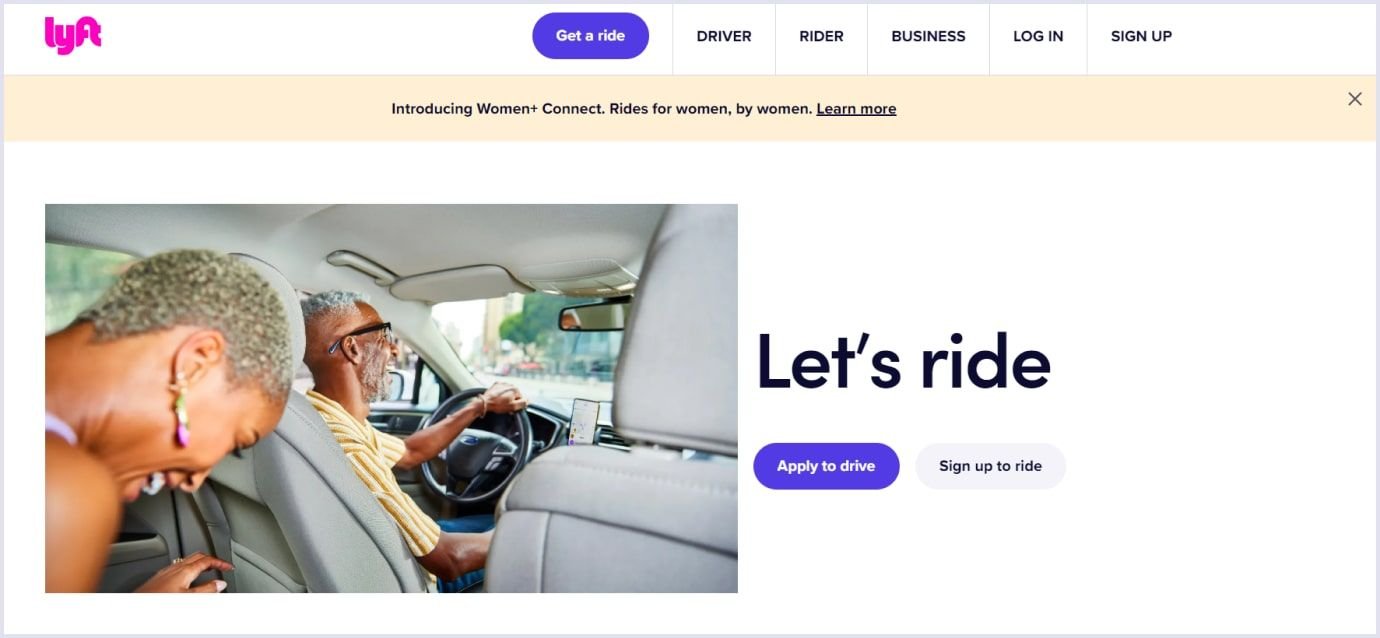
Source: Lyft.com
By location coverage
Geographical coverage also splits ecommerce platforms into two types: local and global.
Local marketplaces
Online platforms that provide products or services for specific locations are called local marketplaces. They offer diverse listings with geographic focus and community engagement. For example, Gumtree and Depop focus on local products and services.
Global marketplaces
Such platforms suggest unlimited product categories and unite sellers and buyers globally. Examples of marketplace giants include Amazon, eBay, and AliExpress.
To sum up, marketplaces differ in several aspects, and the exact selling platforms can fall into different categories simultaneously. For example, Etsy is a C2C multi-vendor vertical marketplace.
Read also: Top 15 Online Marketplace Trends to Watch Out for in 2025
Key benefits of building a marketplace website
Whether you have outlined your marketplace idea or just started creating the e-commerce website, knowing marketplace benefits will encourage you to get the development done. Let’s see what they are in detail.
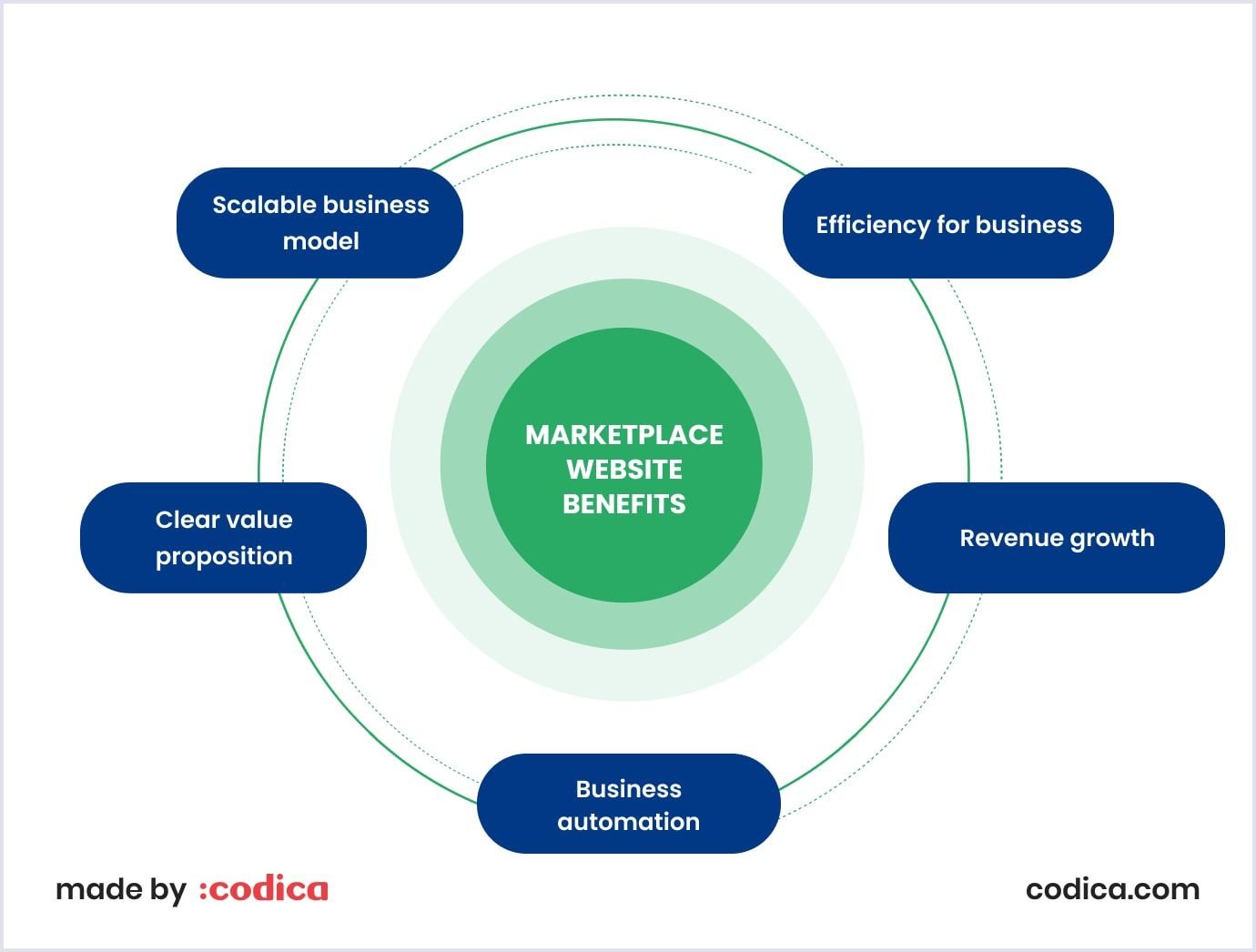
Efficiency for business
What is business efficiency? It is the capability to get higher revenue quickly with fewer resources and effort invested. The following are the online marketplace benefits that lead to better business outcomes with less expense:
- Wider audience reach: the website is a connecting point for local and global users;
- Abundant catalogs: the online marketplace presents customers with a wide range of items;
- Swift transactions: marketplaces allow users to pay for the goods online;
- Streamlined operations: you can automate routine processes, such as inventory management and shipment, for quicker service.
In short, you can improve your business processes with a marketplace website for quicker operations and enhanced user experience.
Revenue growth
The financial benefits of ecommerce come as a result of marketplace business efficiency. As an online marketplace attracts more buyers and sellers and has automated processes, it is easier to gain higher profit. Marketplace owners typically win from fees after transactions. With a broad audience that an online marketplace can cover and automated trade operations, getting more such transactions and relevant commissions is easier.
Business automation
Online marketplaces tune up many processes essential for trading. Product search, filtering, arranging in catalogs, checkout process, payments, and shipping are automated to make the buying process quick.
Also, providing chatbots for customer services and using inventory management systems help speed up marketplace operations and enhance consumer experience. These B2C and B2B ecommerce benefits will keep your online marketplace running.
Clear value proposition
Are you connecting drivers and passengers, retailers and buyers, hosts and guests? These and many more options come as a vivid value proposition for customers. You can choose one niche at the start of your marketplace business.
As your marketplace evolves, you can expand your specialization coverage and target a broader audience. By covering one or more niches, you provide a clear value to your customers and get tangible benefits of ecommerce for a business.
Scalable business model
The top popular business models for online marketplaces are commission, subscription, freemium, listing fee, and lead fee. You do not choose one model once and for all. As your marketplace grows, you can select one that suits your business needs. You can mix these models and change them as your marketplace business evolves. Thus, you will get revenue and other ecommerce business benefits.
To sum up, an online marketplace is a versatile tool to make your customers happy and receive positive business outcomes. Check out our detailed article on marketplace development benefits for your business and customers.

Challenges of creating a marketplace website
Starting and running a marketplace is not a piece of cake in today’s saturated market with big players at the forefront. So, let’s see what marketplace problems you may encounter and how you can overcome them to drive your business forward.
Selecting the right development strategy
When selecting a building approach, you must consider technical, financial, and collaboration aspects. Choosing tech stack and scalability planning must ensure your marketplace website meets industry standards and your customers’ needs. Also, the development process must be optimized. So, you plan and use time and resources in the best way to build an ecommerce website.
A reliable development team or company can help you select the correct technical approach and feature feasibility analysis. It will help you understand what technologies, professionals, budget, and timeline you need to develop your ecommerce marketplace solution. Thus, you mitigate the risk of marketplace issues upfront.
Dealing with the chicken and egg problem
At the start, a marketplace needs help attracting an audience. Buyers won’t explore the platform because there is a lack of sellers. On the other hand, vendors do not have the audience who would buy from them. So, which side do you choose first to help your marketplace evolve?
Companies have successful examples of solving the marketplace chicken and egg problem. The primary approach is to start with the side that is more valuable to you and is more challenging to get. For example, Outdoorsy’s founders directly called RV owners and spoke in person to attract the supply side, which was more difficult. As soon as they got RV owners to their platform, renters also joined it.
Low knowledge of the brand
Another point in the list of marketplace challenges is low brand awareness, which means people need to become more familiar with your company. The better the brand awareness is, the more loyal customers become to your marketplace. They value your platform over other websites and will likely make repeat purchases.
To raise awareness of your marketplace, you can create a recognizable brand identity and build your marketing effort around it. Communicating a consistent brand message to your prospects through social media, influencers, and partnerships is a powerful tool to raise brand awareness. Showing your values and mission as a company can resonate with your audience and pull the balance in favor of your marketplace.
Low rate of client acquisition
Customer acquisition means attracting new clients to your platform to keep your business evolving. Poor customer acquisition rate affects your brand’s visibility and the flow of newcomers.
How do you solve these marketplace issues? Several remedies will help you. First and foremost, provide value that satisfies your customers’ intent and needs. To support that value and communicate it to your audience, use the following methods:
- Create content that is relevant and helpful to your customers and is optimized for search engines (SEO);
- Express your company values on social media;
- Produce videos, podcasts, and ads to improve your marketplace’s visibility on the web;
- Reach out to your customers with personalized emails at different stages of their journey.
High cart abandonment rate
This issue is widespread in the marketplace industry. Shoppers do not finish buying for various reasons, such as required account creation, a tricky checkout process, and hidden costs.
You can optimize the cart feature to reduce this rate by making the cart experience smooth and engaging. Basically, you can add a guest checkout option, be straightforward on the final price, include product thumbnails, and highlight the steps of the checkout process. The goal is to highlight the critical price parameters, security of payments, and flexibility in refunds and returns.
Later on, we cover this aspect in the section on marketplace features in greater detail. Check it out.
Monitoring vanity metrics
These statistics look fascinating, yet they do not bring tangible results to business. Vanity metrics can be video views on social media or the number of followers. These data do not reflect the key parameters, such as engagement and leads, and do not outline how these indicators relate to broad business goals.
The trap of vanity metrics is that they can make you feel optimistic but do not give you the foundation for actionable decisions. Examples of vanity metrics are the total of customers, registered users, social media followers, and number of users gained per day.
Regarding metrics, measure what you need for your marketplace growth, paying attention to quality over quantity. Such metrics should be auditable and understandable to different teams in your company.
Also, remember that every element of your marketplace’s user experience needs testing with real people. What seems to you as consistent and convenient might be frustrating to your customers. You can obtain the results that matter for your growth by approaching these online marketplace challenges.
Essential features to build a marketplace website
Functionality is at the core of your marketplace website. The well-thought-out marketplace features ensure that your customers find what they want and get help during their interactions with your website.

Below, we discuss the primary marketplace website features that help customers reach their selling and buying goals.
Simple signup process
Coming to your marketplace and searching for products takes customers’ time and effort. At last, they are ready to buy that specific product on your marketplace. The next for them is the signup process.
Try to keep it simple, clear, and prompt. This way, you will retain a customer who is willing to buy on your platform. How can you achieve it? The following are best practices to make your signup feature frictionless and engaging:
- Include a compelling headline, a short registration form, and a vivid call to action;
- Aim to a one-step registration process, such as entering email and password;
- If your signup process takes more than one step, highlight the steps with a progress bar;
- Give the option to sign up with Google, Facebook, X (Twitter), or similar accounts;
- Define the signup and sign-in processes with separate buttons;
- Validate your signup versions with A/B tests to check which option is best for your customers.
Additionally, you can highlight the benefits of an account and how you secure customers’ personal information.
For example, Macy’s, a department store company, offers a separate signup form. It is short and requires basic details. A thoughtful headline outlines that the signup is secure. Also, users can read what benefits they get by creating an account. The incentives include easy checkout, tracking orders, and access across different devices.
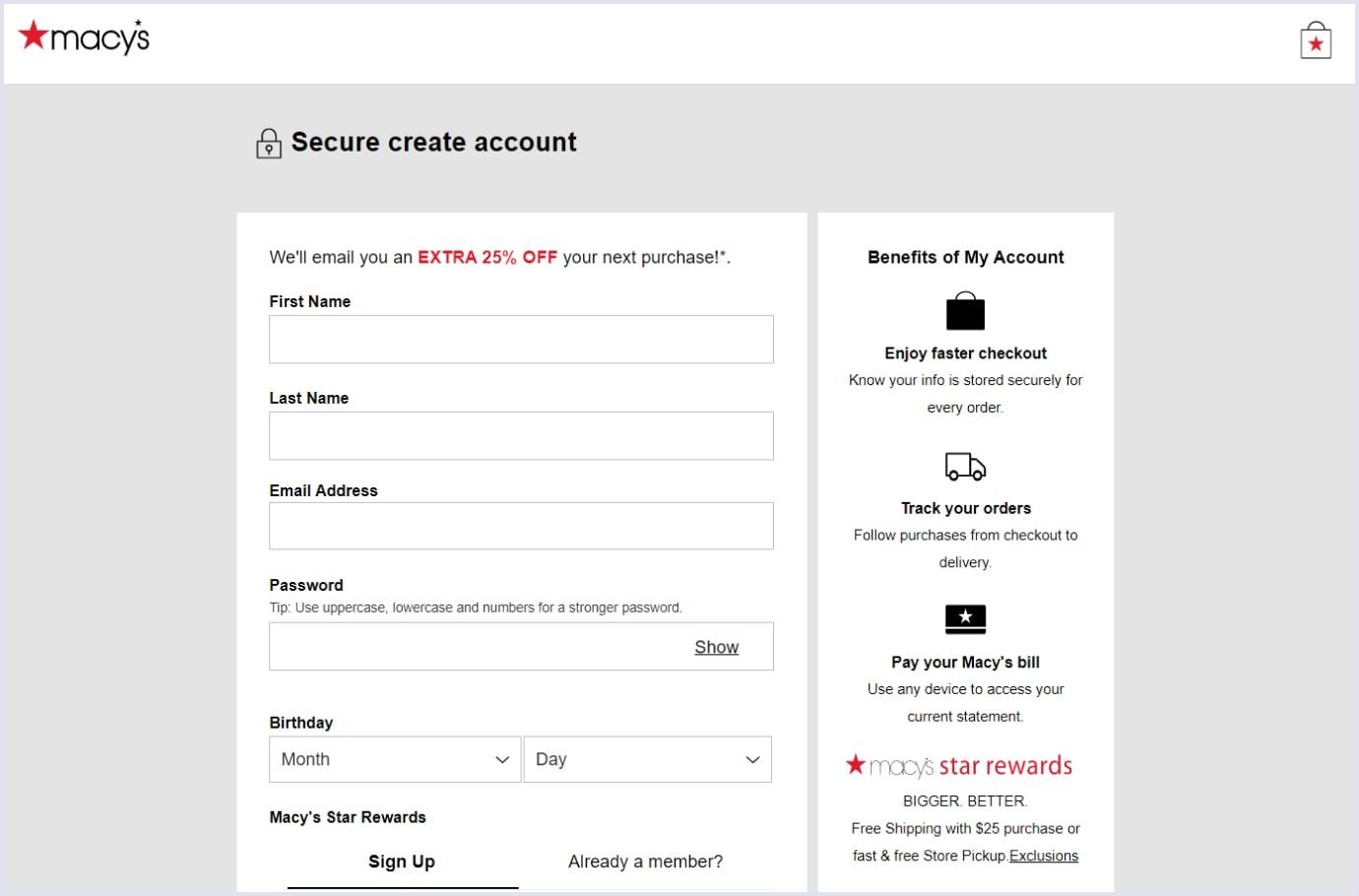
Source: Macys.com
Profiles
Depending on the marketplace type by engagement, profiles include buyers' data or buyers’ and sellers’ information. You can join both in one account. Typically, a profile contains personal information, preferences, order history, and payment methods. Also, you can suggest notification settings to personalize user experiences.
For example, Udemy provides an opportunity to be a student or teacher and switch between these roles with marketplace features. Profiles on Udemy are customized to users' goals. Students can save courses, add wishlists, see archived courses, and add learning reminders.
On the other hand, instructors are provided with communication tools to connect to students and software tools for course creation. Also, teachers can view their performance and track crucial indicators, such as reviews, course engagement, traffic, and conversions.
Easy custom search
The primary aim of people coming to your marketplace is quickly finding the desired products. That is why a swift search is a must-have for your marketplace. Following the best practices, make your search as convenient as possible. Today, the following search enhancements are available:
- Give a placeholder in the search bar to highlight the feature for your customer;
- Provide similar search options while a customer types the word for a product in a search bar;
- Give suggestions with featured or trending products or listings;
- Provide search based on price, shipping, and delivery types;
- Optimize search with filters;
- Provide recommendations based on past searches;
- Ensure cashing to show search results quickly;
- Foresee synonyms, acronyms, and misspellings in search;
- Include proper indexing based on product categories and descriptions.
For example, Udemy, a leading education platform with over 250,000 courses, highlights featured courses when you type words in the search bar. Along with popular searches, you get a grasp of featured or top courses available per your search.
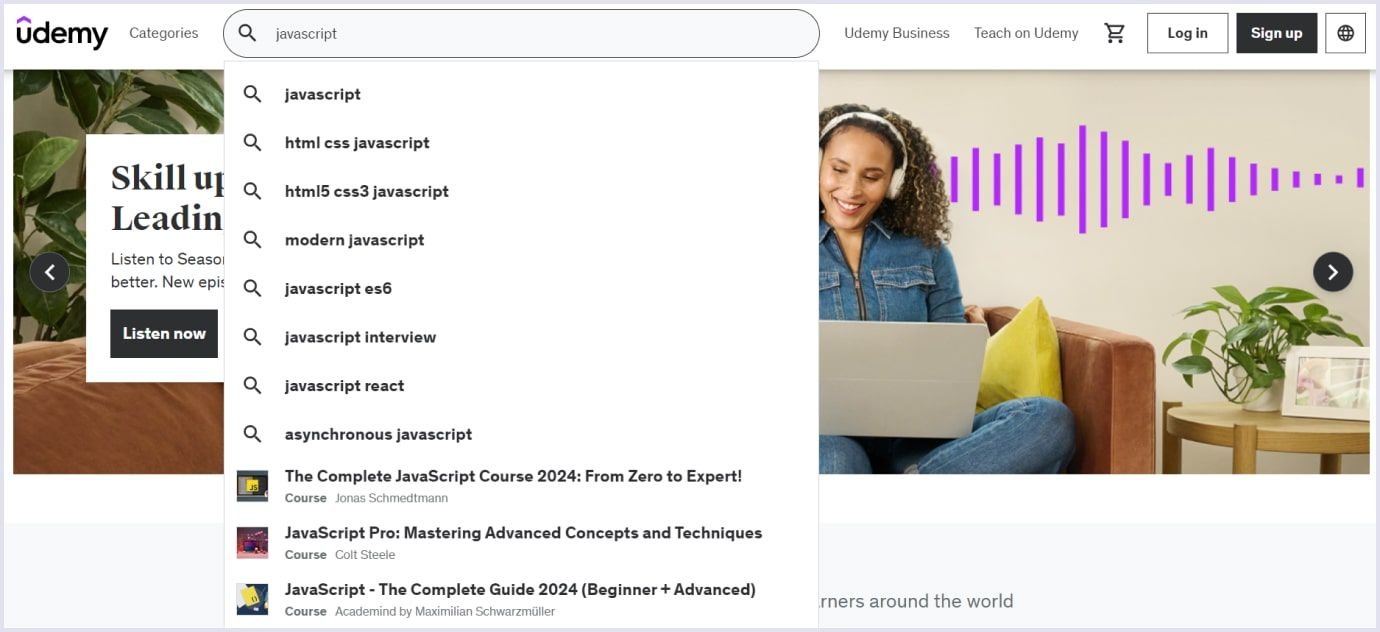
Source: Udemy.com
Filters
This marketplace feature helps shoppers narrow their search by specific criteria. Thus, buyers can select specific properties to find the best match for their preferences.
Basic filters include ranking by price and product type. Depending on the category, your marketplace will suggest additional filters. For example, the Vinterior marketplace for vintage furniture provides comprehensive filters in a drop-down menu.
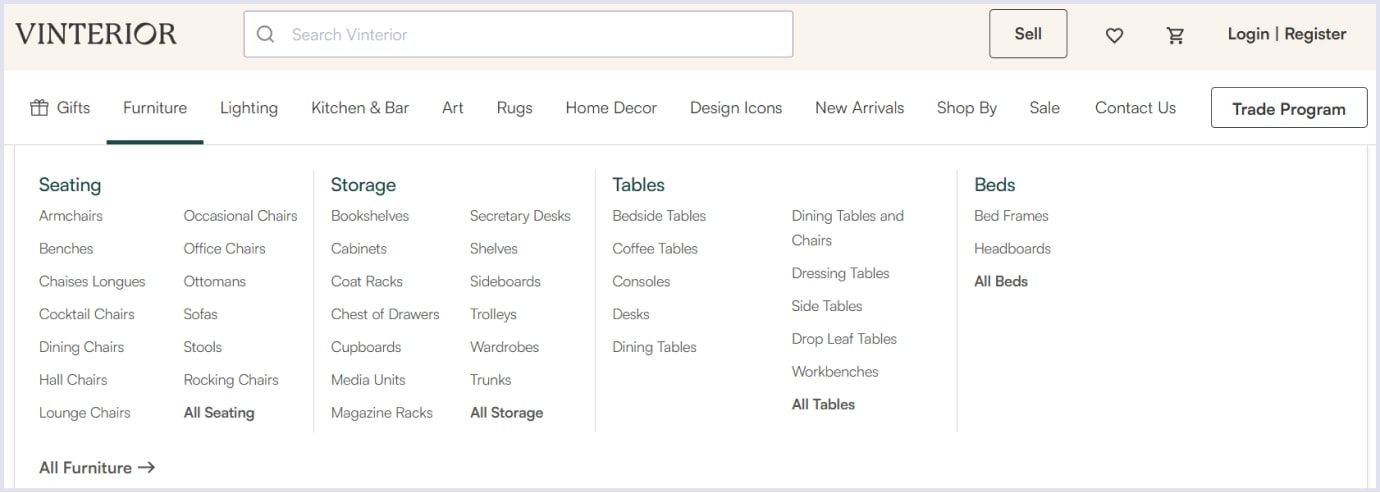
Source: Vinterior.co
Advanced product page
This feature shows the product’s properties and helps shoppers find and select desired items. Key components of the advanced product page include the following:
- High-quality images;
- Detailed product description;
- Information on availability;
- Product variants;
- Customer ratings and reviews;
- Price and discounts;
- Shipping and delivery information;
- Related or complimentary products.
The product page enhances the user experience with options to buy now or save the product for later. Also, sharing the item on social media helps get exposure to a broad audience.
Shopping cart
According to the Baymard Institute, the average cart abandonment rate is 70.19%. So, around 3 shoppers out of 10 do not complete buying. As the reality of online buying, the abandoned cart affects marketplace revenue. The good news is that you can improve your shopping cart design and make buying easy and delightful. That means better conversions and more transactions.
We have prepared a list of best practices to design your shopping cart to help customers finish their purchases. Here is the list:
- Suggest free shipping for orders above a specific amount;
- Show your trust badges to prove the security of your platform;
- Outline logos of popular payment solutions in the shopping cart that highlight an easy payment process;
- When a customer adds items to the cart, offer them to continue buying or proceed to checkout;
- Display the number of items in the cart;
- Make the cart icon accessible from any page of your marketplace;
- Allow for checkout as guests;
- Keep the checkout process on one page or show a progress bar for several steps;
- Provide autofill for details in the checkout form;
- Keep shipping costs, taxes, and other fees transparent and give a clear and accurate total.
For example, Etsy provides a well-thought-out shopping cart design. When you add an item to the cart, the relevant page outlines the payment options, total, discount, and shipping price. Also, the page highlights purchase safety and protection against delivery risks. These e-commerce marketplace features ensure that customers will enjoy buying.
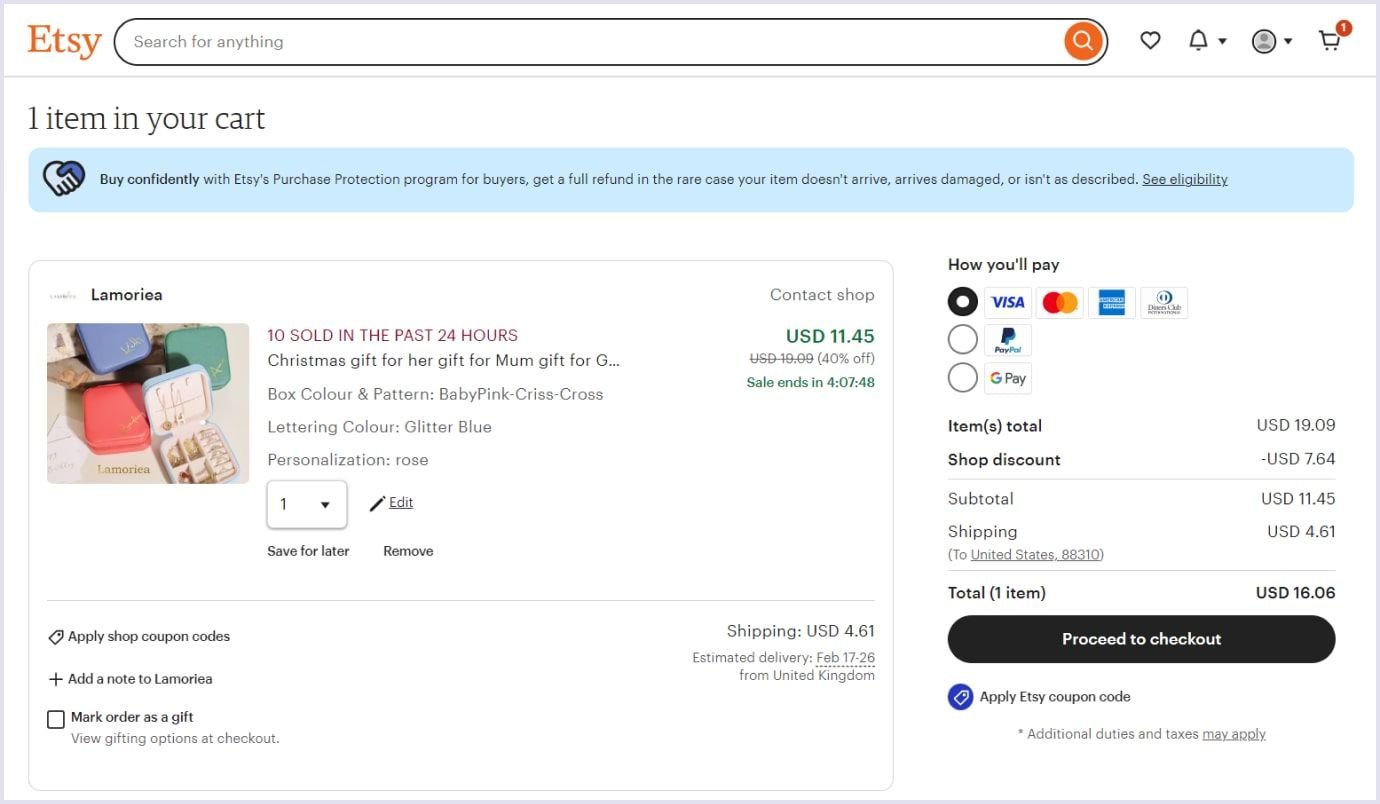
Source: Etsy.com
Guest checkout
When visiting your marketplace for the first time, customers are unsure if they will buy again on your platform. So, enabling guest checkout is a straightforward way to engage more visitors and increase sales.
This feature also supports your adding items to the wishlist as a guest. Thus, your one-time buyers receive advanced experience. So they are likely to make repeat purchases.
Transparent navigation
Your customers’ primary goal is to explore your marketplace website and find specific products. If your navigation is easy, customers will get a positive experience and will likely buy. The result is higher conversions and cart totals. Otherwise, cluttered or unclear navigation leads to bouncing when customers do not finish their intended action on your website.
To make navigation convenient, follow these simple and efficient techniques:
- Plan out your website navigation structure and look;
- Guide a user from significant categories to one-layer subcategories or pages;
- Use recognizable signs for the menu, such as three horizontal stripes or three dots;
- Create a menu with simple words concisely depicting menu points;
- Create a mobile-first navigation that will look nice on screens of different sizes.
For example, Bassett, a platform that offers furniture and other home products, provides a combined navigation style. It helps you view categories and subcategories with horizontal and side menus. This approach keeps navigation smooth and clear.
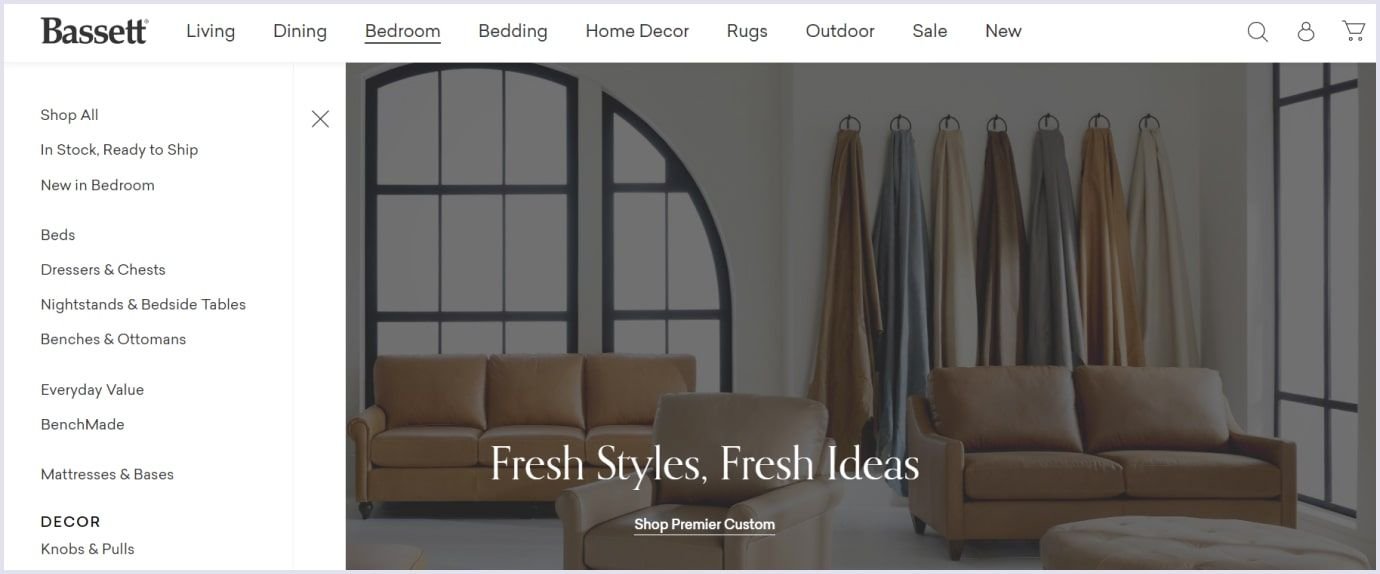
Source: Bassettfurniture.com
Messaging and chat
Marketplace provides a place for many interactions. Buyers ask sellers questions about specific product or service details, arrange delivery, track shipment, and resolve issues. For such diverse interactions between buyers and sellers, messaging and chat are a must-have to keep your marketplace running.
Technologies can help you enhance the messaging feature. Thus, you can personalize this feature for specific user preferences in the following ways:
- Schedule push/email campaigns;
- Personalize messages based on user behavior;
- Send reminders and notifications;
- Use targeted messaging to deliver tips, promotions, and updates;
- Leverage messaging to highlight deals closed in direct messaging between a buyer and a seller.
For example, Shopify released an app to help sellers contact buyers on many issues. With Shopify Inbox, buyers can monitor conversations from their admin. Moreover, the app helps see what items shoppers have in their carts during conversation and which chats will likely lead to sales.
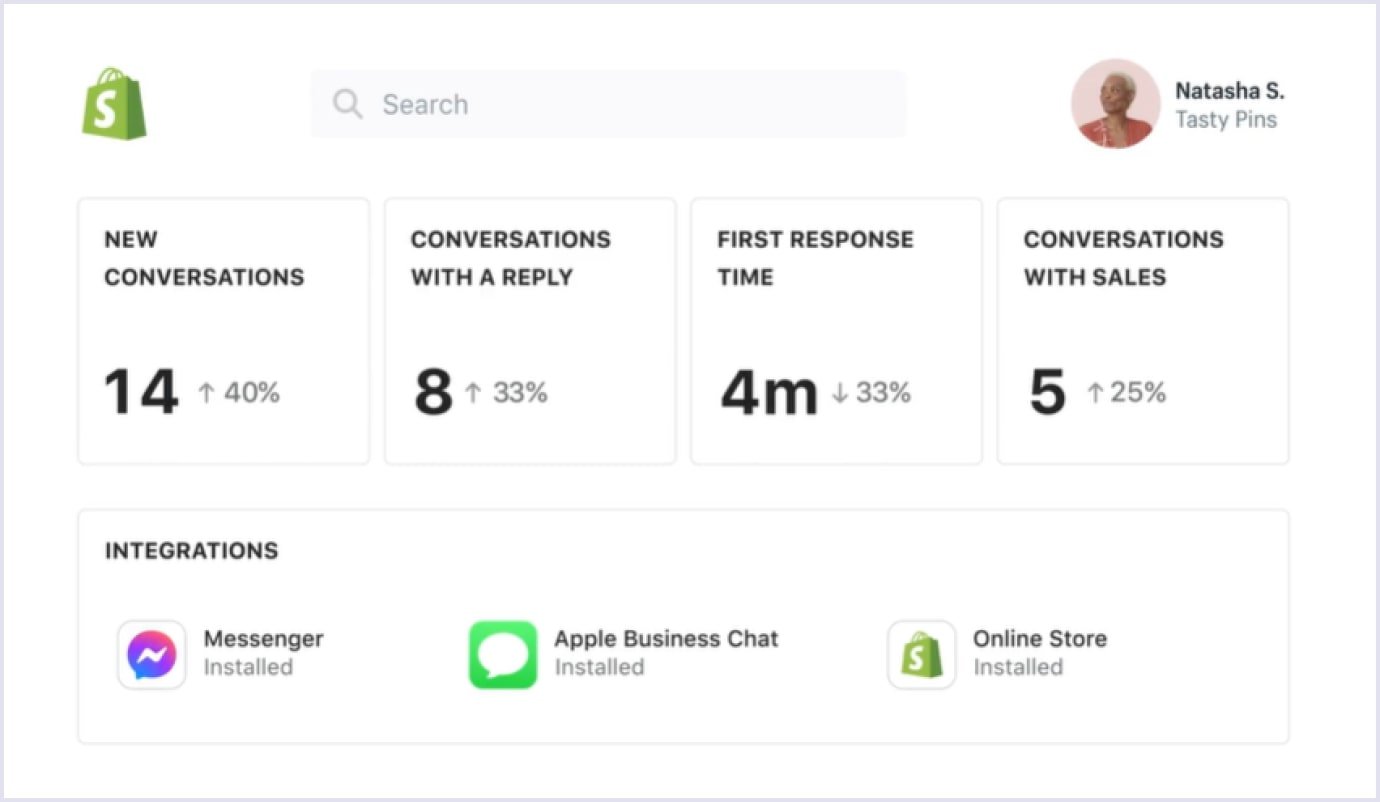
Source: Shopify.com
Advanced vendor dashboard
This comprehensive feature is mainly used with multi-vendor marketplaces. A vendor dashboard helps sellers manage orders, payments, and shipments and check performance indicators and other crucial sales data. Also, a dashboard allows vendors to provide feedback on marketplace work and get support if needed.
The dashboard brings to sellers the following essential elements:
- Product management to add, update, and edit item listings, including price, quantity, description, images, inventory, and stock. You can enhance it with intelligent data incorporation for consistent descriptions of the same products from different vendors;
- Order management to manage and track incoming orders, update order statuses, and manage invoices and shipping labels. Make it customizable to help sellers choose the features they need for their business;
- Inventory management to receive notifications of shortages in stock and manage stock replenishments. This feature helps vendors to save money, streamline cash flows, and improve shoppers’ experiences;
- Bulk import to import product data. This feature improves vendors’ experiences as they can import product descriptions in bulk without adding items one by one. For example, vendors can import product details to a marketplace from their enterprise resource planning (ERP) system;
- Sales reports and analytics to optimize sales strategies based on performance indicators. These data help vendors monitor sales, customer behavior, conversion, and retention rates;
- Communication tools to help customers with product details, resolve issues, and provide customer support. With these features, vendors can understand the sources of questions and problems and help shoppers quickly find what they need;
- Commission and payment tracking to view earnings and commissions from the online marketplace. Keep the commission and payment policy clear for vendors so that they can understand their revenue gain and deductions.
Vendor dashboards can be even more sophisticated for larger marketplaces. Let’s take Amazon as an example. They provide a platform for sellers with essential B2B online marketplace features. Watch the video below for what their Amazon Seller Central vendor panel includes.
Ratings and reviews
BrightLocal’s recent research shows that 76% of customers read reviews before buying. Ratings and reviews help buyers get handy information and encourage sellers to improve their products and services. Thus, these online marketplace features promote customer engagement and make your platform trustworthy.
It is helpful if you provide several options to give a rating and review:
- General rating with stars or similar points;
- Rating for specific parameters, such as product quality, order processing, and seller’s response to queries;
- Open-text responses with specific questions;
- An option for users to edit and remove their reviews and ratings;
- A feature for sellers to respond to ratings and reviews.
For example, Etsy allows buyers to assess the item quality and shipping time and give a rating. Also, buyers can give a thumbs-up assessment to other shoppers’ reviews and show that a review is helpful. This way, the marketplace makes users’ feedback more accurate and promotes helpfulness.
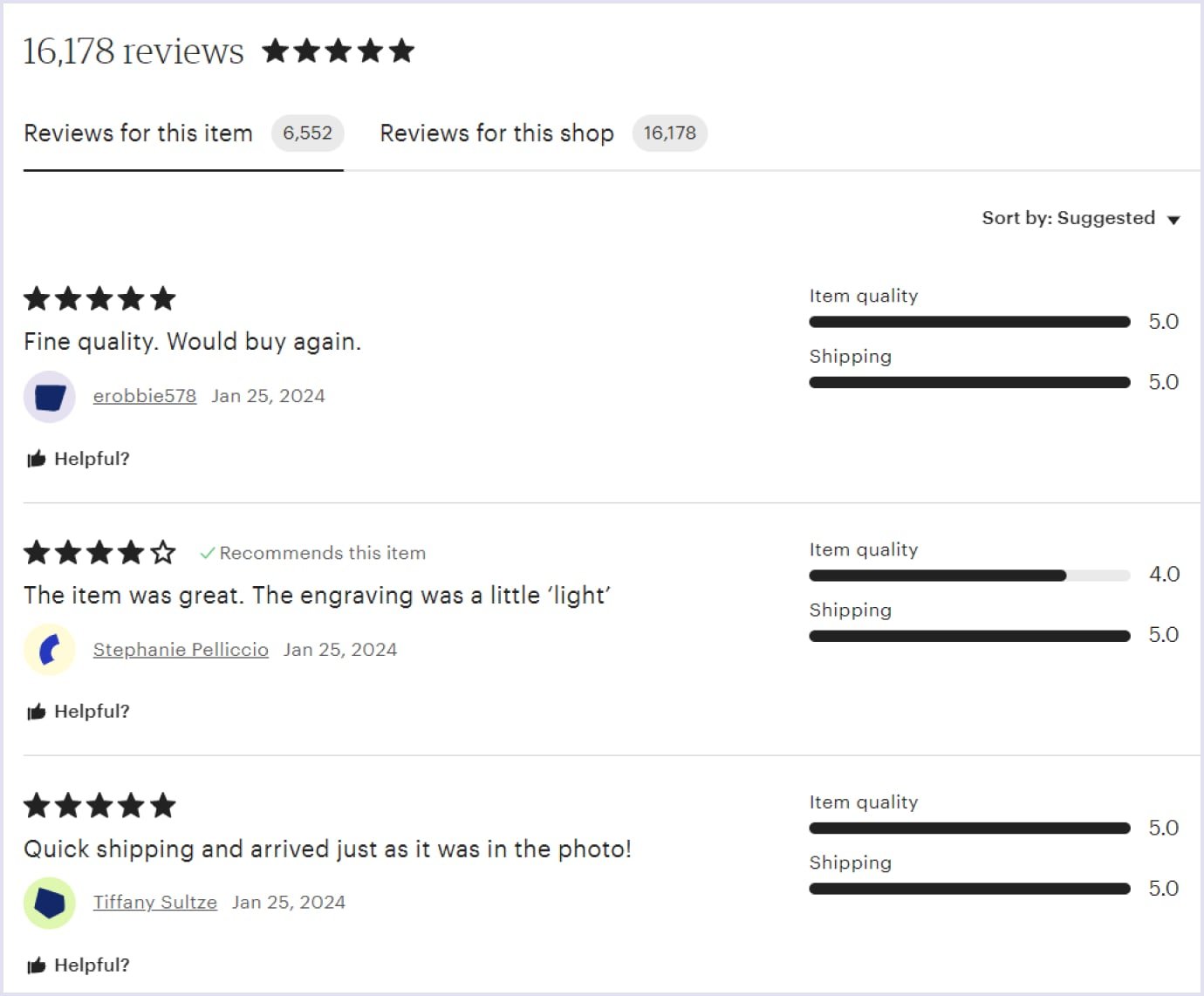
Source: Etsy.com
Customer support and chatbots
An excellent customer experience is crucial to customer retention and conversions. As Zendesk shows, 8 in 10 customers say that AI chatbots are helpful with simple issues. Also, 72% of active users of customer service bots note considerable service improvement.
So, how can you provide better customer support in your marketplace? In fact, you have plenty of channels for that. You can use classic tools, like email, phone, or in-person support, along with online chat and social media engagement. Check the image below from Salesforce research to see how else you can set up customer support on your marketplace.
A self-service chatbot is another helpful tool among product and service marketplace features. Powered with AI (artificial intelligence), chatbots provide users with answers to queries on products, services, bookings, orders, shipments, and other common issues.
Chatbots can provide a human-like experience and process queries from many customers in one go. Thus, they drive your customer satisfaction.
Artificial intelligence in online marketplaces
Today, leading marketplaces enhance typical features with AI to provide better services to customers. Below are several use cases of AI usage that you can also consider when building your online marketplace:
- Personalized recommendations. Based on what buyers have searched, AI can suggest similar “you may also like” or complementary products, like style recommendations. For example, Amazon highlights products customers buy and the items they search for. In fact, 60% of brands in the US and UK implement smart recommendations based on past experiences;
- Enhanced search and filtering. AI technology recognizes the search intent. So, even in case of a vague and incorrect search, your buyers will get the highlights they want. For example, Walmart introduced a GenAI search that helps select products by occasion, for example, simply enquiring, “Help me plan a football watch party!”
- Chatbots and virtual assistants. These technologies help you improve customer service in your marketplace. Chatbots powered by AI answer simple queries and make it easier to streamline order processing, tracking, returns, and payments. In addition to these functions, virtual assistants can guide buyers through catalogs, give advice on matching products, and more;
- Assisting in sales management. AI processes data from customers, which covers thousands of daily interactions. So, you can help your sellers track orders, manage returns, refunds, promotions, and discounts, and set dynamic prices. Moreover, sellers and owners can get analytics that will help in planning sales strategies.
Regarding AI advantages, we help businesses integrate it in marketplaces with our AI development services. Thus, you get enhanced features and greater conversions for your selling platform.
You may also like: The Role of Generative AI in Marketplace Development
Marketplace integrations
Today’s fast-paced ecommerce world provides sellers and brands with various opportunities to expand their audience reach. Online marketplace integrations are such a method. In a nutshell, it is software that connects your service platform with a marketplace. The integration tools provide versatile features to track your products, stock, orders, shipment, and more.
Let’s discuss popular integrations that you can use in online and multi-vendor marketplace development.
Product feed management
As marketplaces thoroughly check product data before listing them, keeping your product feed accurate and up-to-date is vital. Product feed management means collecting, optimizing, and spreading product data across selling channels.
Well-organized and explicit product data help marketplaces like Amazon or eBay understand product descriptions correctly and display them effectively.
For example, ChannelEngine, a platform for ecommerce, connects brands and retailers to various marketplaces. Its comprehensive set of tools includes product listing control in the following aspects:
- Product data import, including descriptions, images, and attributes, across various marketplaces;
- Optimization of product data with an intelligent content and attribute mapping method;
- Stock and order synchronization and delivery across multiple channels;
- Creating virtual product bundles with AI technology for enhanced user experience.
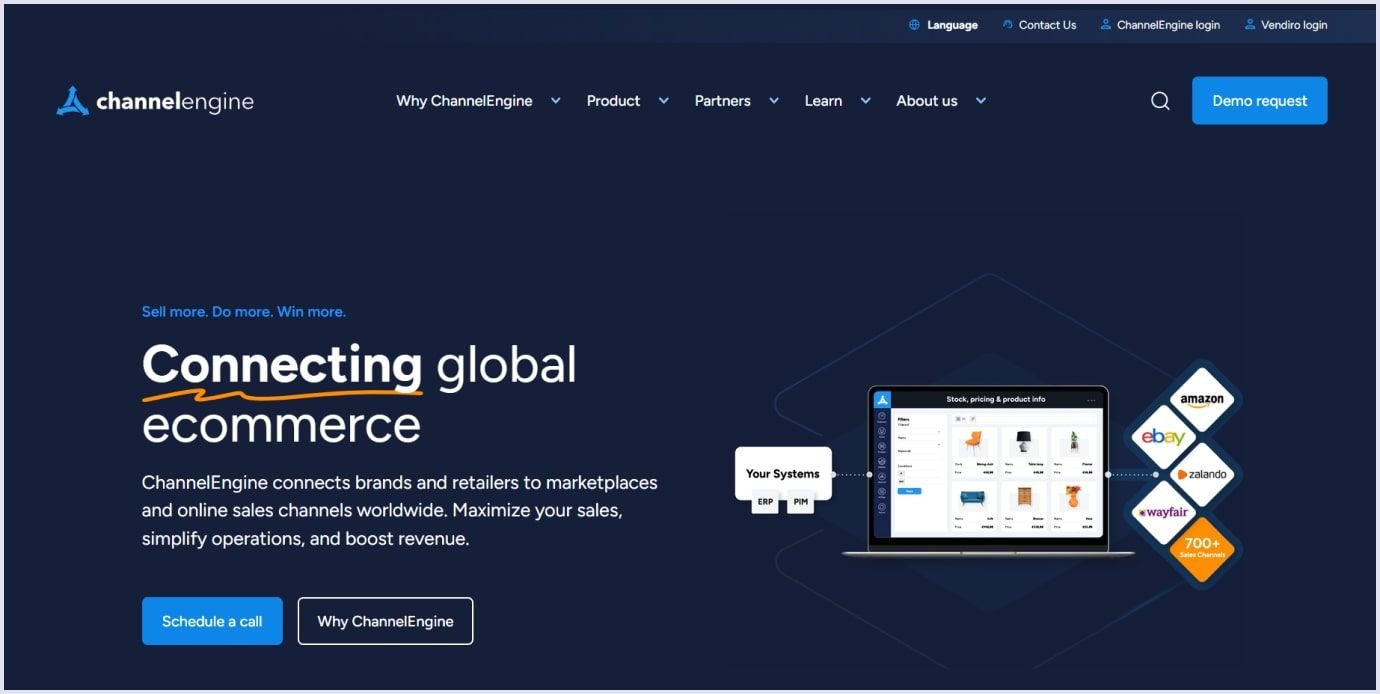
Source: Channelengine.com
One more example is Jungle Scout, a software-as-a-service platform offering marketing and sales technologies and analytics to sell on Amazon. The suite includes Product Tracker, which is a tool with the following product management services:
- Tracking real-time sales, revenue, and best-selling products;
- Custom organization of groups of similar products;
- Observation of critical metrics, such as daily product sales, prices, and more;
- Writing product notes;
- Exploring recommended product ideas.
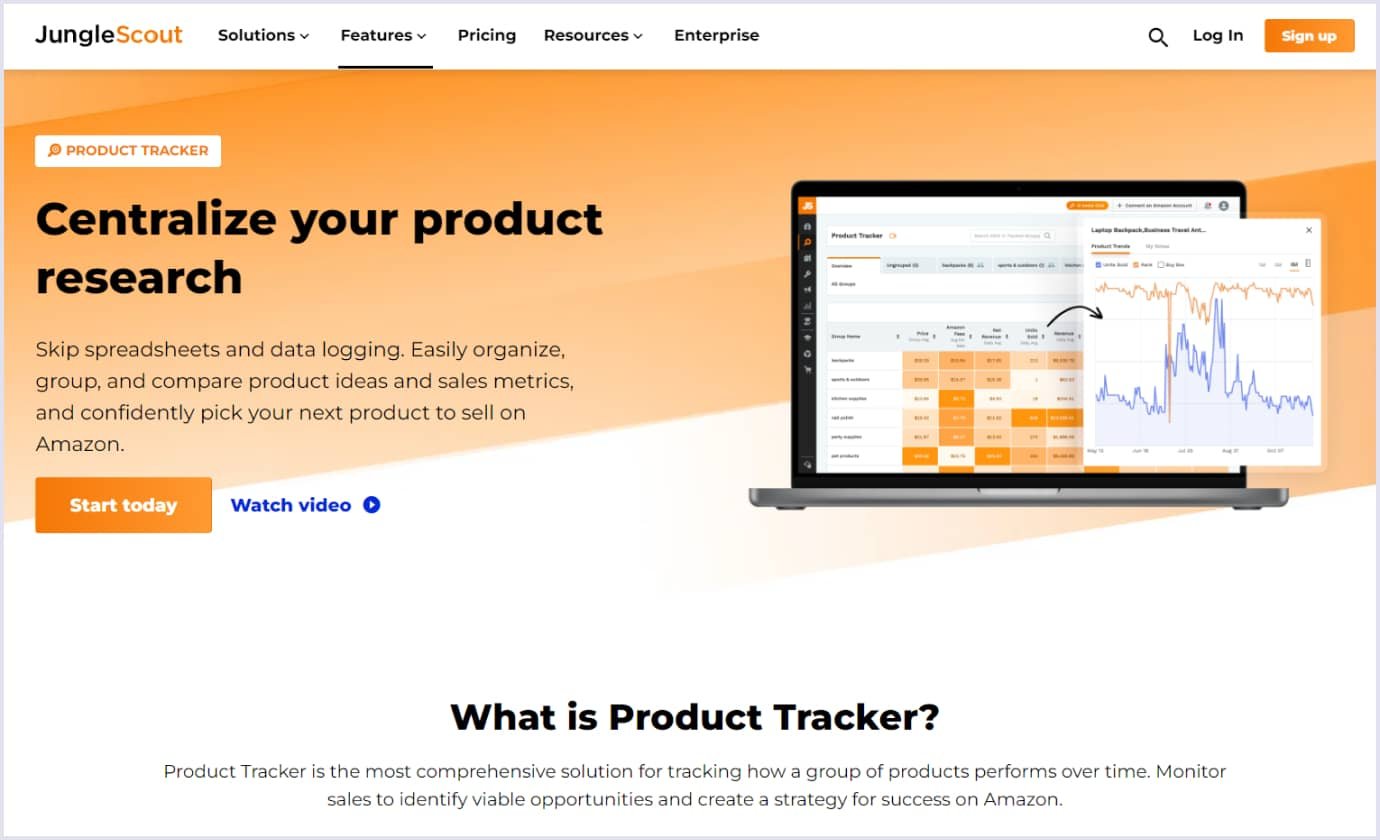
Source: Junglescout.com
Order management
The order journey starts when a shopper clicks the buy button. An order management tool helps with receiving, tracking, and fulfilling orders. Ensuring timely deliveries, easy replacements, and frictionless returns is necessary.
The following are the benefits for your marketplace from this integration:
- Keeping the right level of stock. The order management system helps you keep your stock in line with the orders you get;
- Streamlined fulfillment of orders. Thanks to process automation, the system lets you narrow your focus to quick order delivery;
- Making informed decisions. The integration provides necessary data on order distribution, splits inventory depending on locations, and identifies real-time issues;
- Better focus on strategic activities. You can focus on sales and other business improvements and strategies with automated routine tasks.
A prominent example of an order management app is Order Desk. Being on the market since 2014, it helps sellers optimize their operations with orders. The app provides a vast pool of features and integrations, including the following:
- Order automation with Rules Engine to split orders, add data before fulfillment, and filter orders by country;
- Organization of order workflow in custom folders;
- Tracking payments and processing full and partial refunds;
- Building customized receipt templates;
- Generating reports by SKU for easy pick-and-pack.
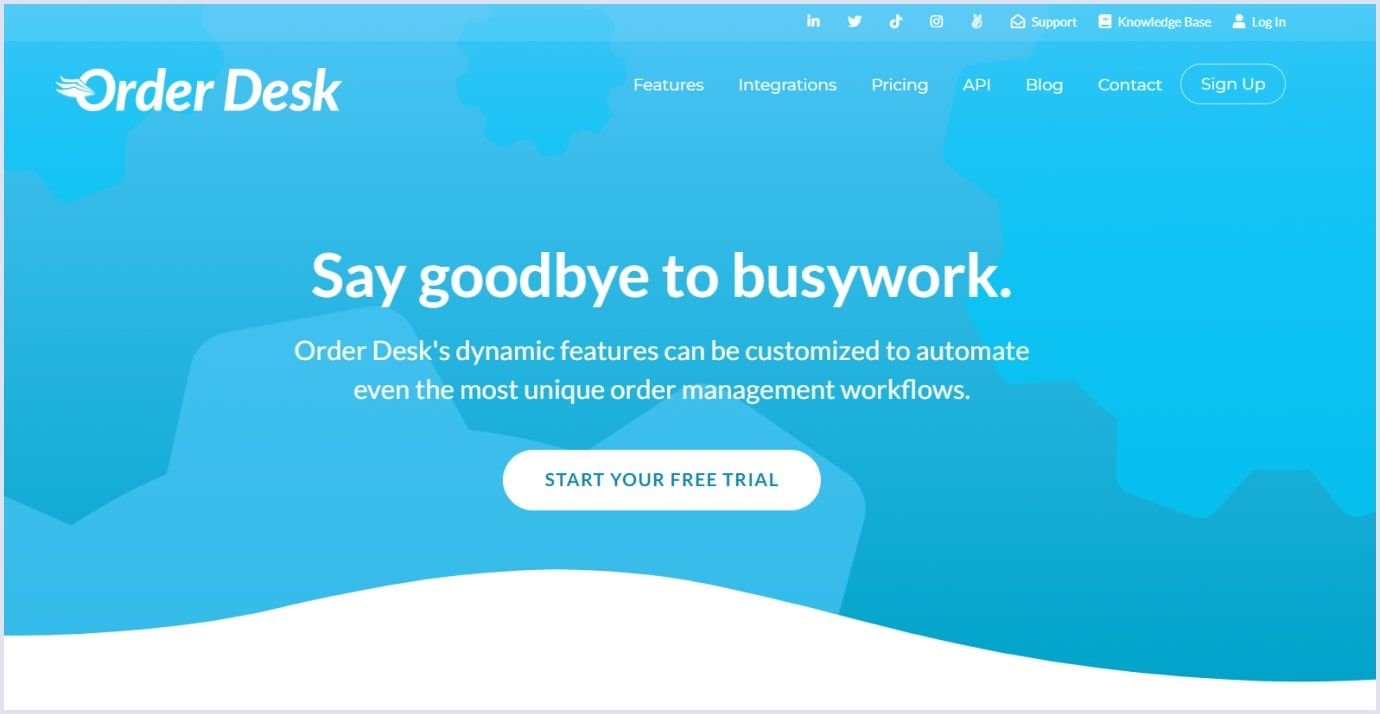
Source: Orderdesk.com
Shipment tracking
As online marketplaces operate on a different scale, from local to global, shipment tracking integrations should meet the relevant requirements. Thus, shipment tracking software offers tools to see transit times, real-time updates on shipment supply, delivery status updates, automated billing, and order management. With those tools, such online marketplace integrations bring the following benefits:
- Strengthened trust in the marketplace platform;
- Peace of mind for sellers managing their shipments;
- Lower traveling and transportation costs thanks to outlined routes;
- Tracking shipment statuses and precise delivery schedules;
- Enhanced security with instant notifications on shipment status;
- Superior customer service with easy shipment tracking.
For example, ShippingEasy, a convenient platform for shipment tracking, boasts an intuitive interface, automated workflow, seamless integration, and unlimited support. As proof of those benefits, the platform offers the following functionality:
- Automated shipment with delivery preferences, mapping rules to order management, and adding insurance to particular shipment types;
- Integrations with unlimited marketplaces, unlimited shopping carts, accounting, listing engines, and other services;
- Support of various labels and barcode scanning;
- Reports on shipments, orders, and unshipped products.
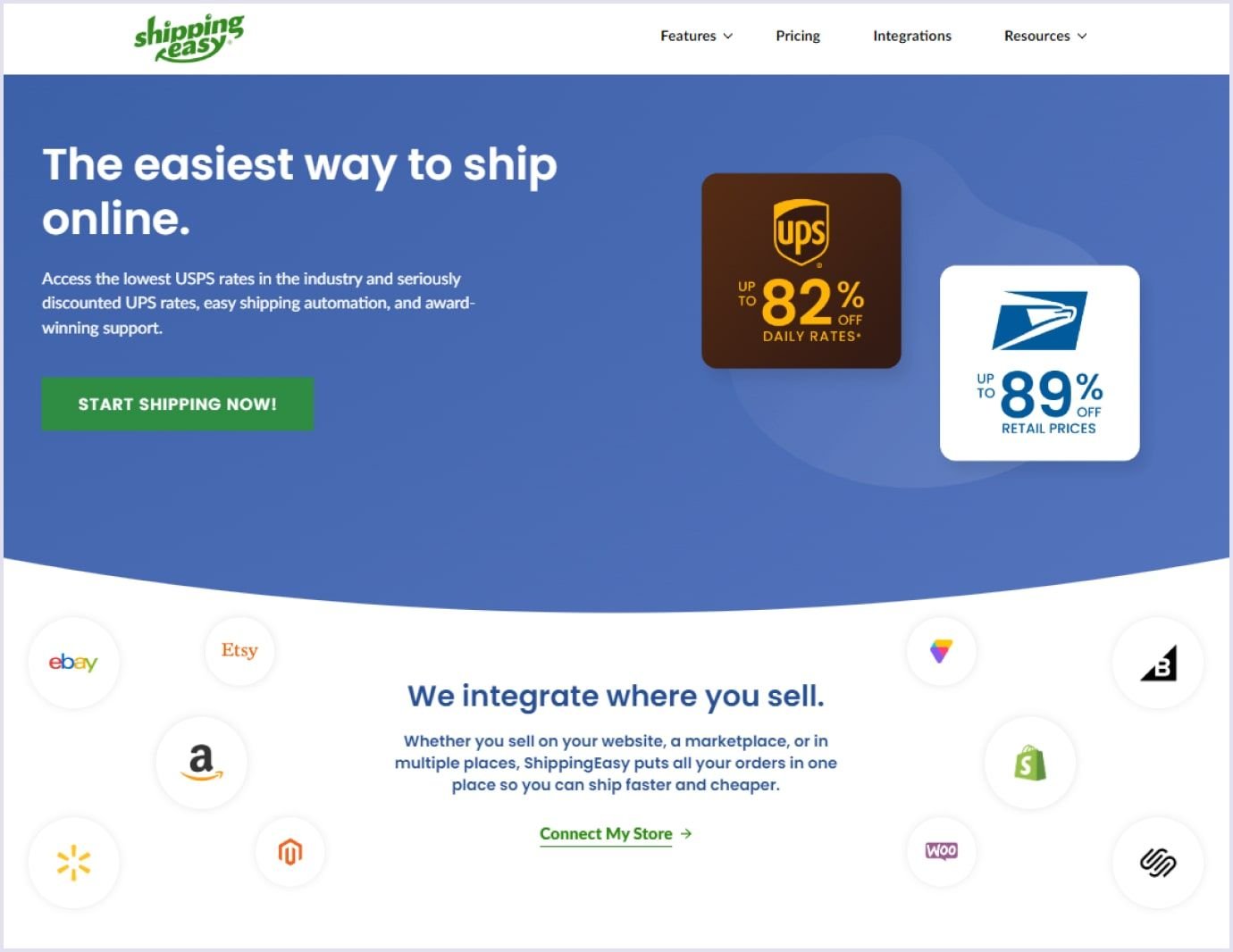
Source: Shippingeasy.com
Inventory management integrations
Proper inventory tracking helps sellers optimize stock flow. It brings positive results for managing products and optimizes other essential aspects of the sales process across many channels. Thus, sellers get streamlined operations, which means more transactions for a marketplace and enhanced customer experience.
In particular, inventory management integrations in a marketplace bring the following benefits:
Optimizing inventory tracking and replenishment to keep inventory just enough without over or understocking; Reducing costs thanks to accurate stock monitoring and improving inventory turnover; Providing better service for customers with on-demand product supply.
For example, SellerChamp is software that provides tools for retailers, resellers, dropshippers, and more. It includes the following features:
- Inventory synchronization across different sales channels, such as Amazon, Walmart, eBay, or Etsy;
- Bulk lister to list thousands of products with an intelligent system;
- Order fulfillment by connecting with partners via built-in integrations;
- Repricing based on competition and sales speed.
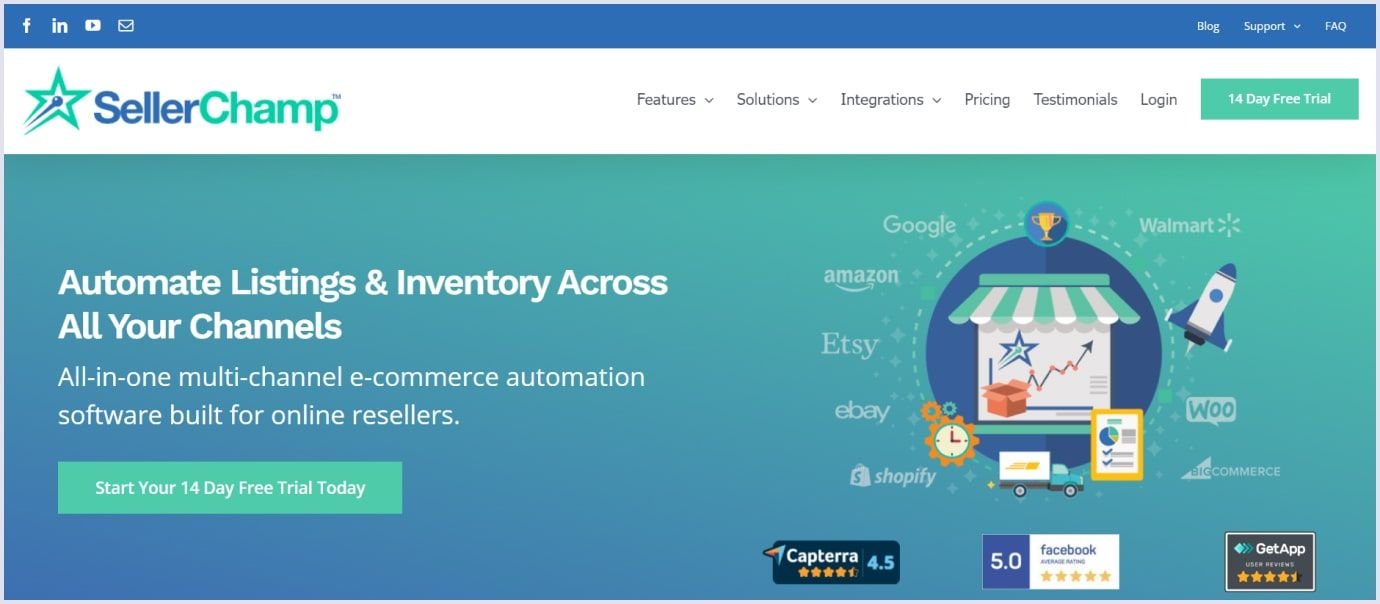
Source: Sellerchamp.com
Payment processing integrations
Flexibility in payment options encourages shoppers to buy and benefits sellers and marketplace owners in more transactions. Choosing the proper payment tools is vital when considering and testing marketplace integrations.
The most popular payment integrations for marketplaces include the following:
- PayPal;
- Stripe;
- Braintree;
- Dwolla;
- Mangopay;
- Adyen;
- Exactly.
For example, Poshmark, a fashion and decor marketplace, highlights the payment option on the product description page. The website outlines PayPal as a swift payment gateway. Also, it suggests PayPal payment in installments. So, you can get a product at once and split payment for it, which makes the buying process more convenient.
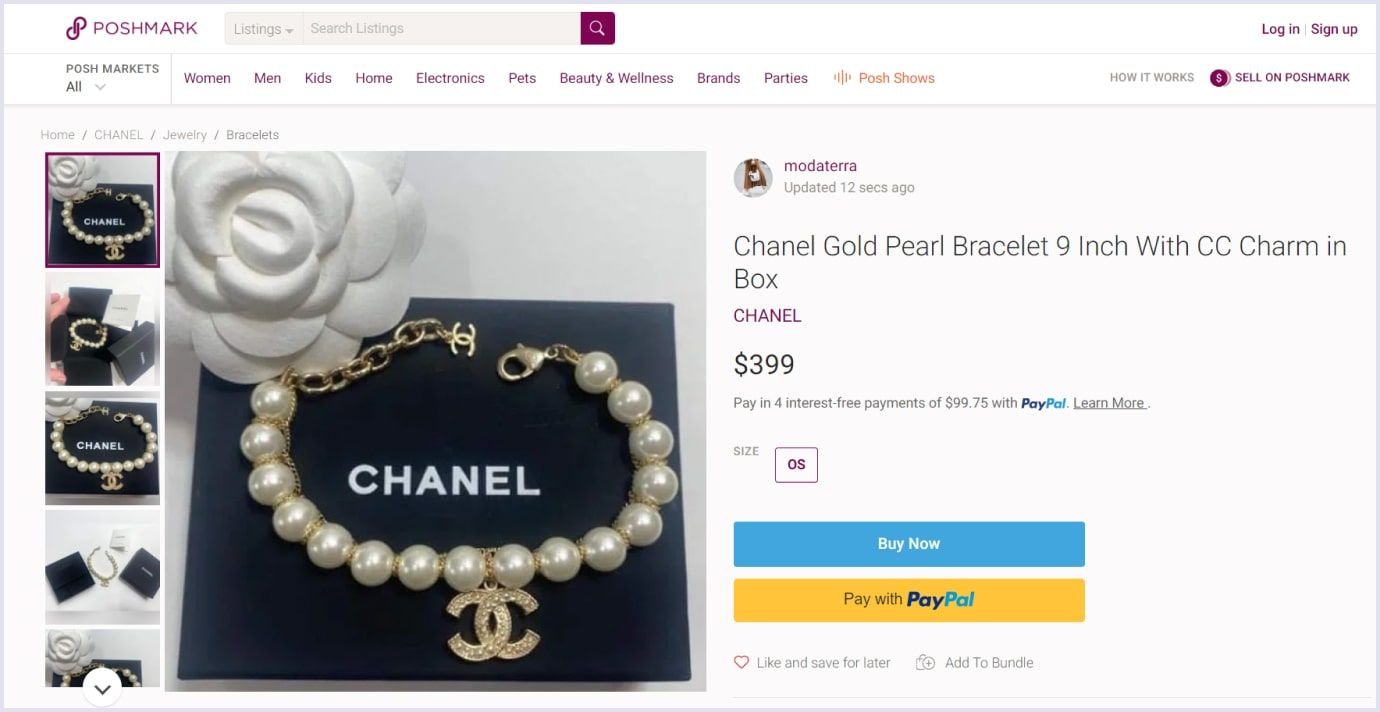
Source: Poshmark.com
At Codica, we know that proper payment integration is essential for smooth marketplace operation. So, it is no surprise our clients often ask for PayPal or Stripe integration. The gateways provide a wide coverage of currencies, follow the best security practices, and ensure flexible payment options.
Detailed analytics dashboard
This feature covers processes of sellers’ and buyers’ activities and provides marketplace owners with valuable data. Based on the dashboard analytics, you can view where your marketplace performs excellently and which aspects you can improve.
Dashboard features can vary depending on the marketplace’s services and needs. At the same time, specific features define the foundation of marketplace analytics. They are as follows:
- Number and trends in marketplace visits;
- Unique visitors during a selected timeframe;
- New, retained, and churned customers.
Among essential metrics you can include to measure marketplace performance are the following:
- Number of active buyers and sellers that use your platform;
- Number of transactions - successful matches of buyers and sellers;
- Total order value - the revenue and growth of the marketplace;
- Cost per acquisition (CPA) - the cost of winning customers through a particular channel;
- Customer acquisition cost (CAC) - marketing costs relative to engaging new users;
- Average order value - the average value per transaction;
- Buyer-to-seller ratio - the number of sellers who are also buyers;
- Quick ratio - the percentage showing if growth outpaces churn;
- Abandoned cart metrics - the data showing patterns and statistics in cart abandonment.
For example, a custom e-commerce solution that Codica built to cover B2C and C2C segments includes relevant data highlights. In the platform’s dashboard, we divided data on orders and products for each sector, along with the corresponding data outlines. Moreover, the dashboard highlights the dynamics of retail and service and the number of orders over time.
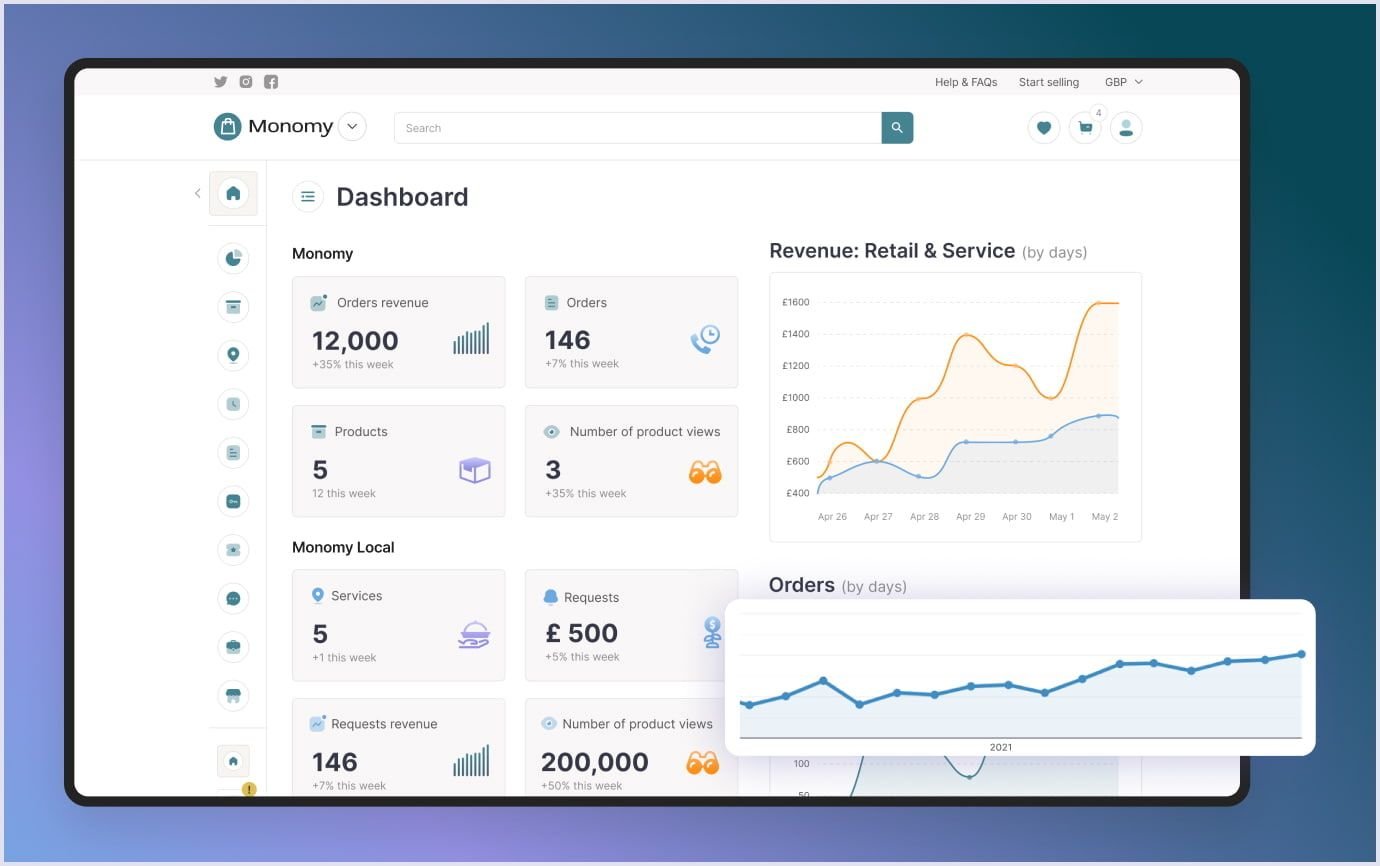
Marketplace payment solutions
In addition to payment integrations, you can simplify operations with several marketplace payment solutions for a better service. They are as follows.
Digital wallets
These online marketplace payment solutions are handy because they speed up and ensure the safety of transactions. You can input your payment details once and then enjoy swift shopping across various marketplaces. Leading trading brands have created digital wallets to streamline user experience with online selling and buying, such as Google Pay, Apple Pay, Samsung Pay, Alipay, and Walmart Pay.
Digital wallets help marketplaces avoid friction during the checkout process. Also, e-wallets secure payments with reliable authentication and enhance authorization rates from card issuers.
Escrow payment system
This payment method means that funds to be paid are held and will be released when the contractual conditions are met. Typically, a neutral third party keeps the escrow and releases it when the conditions are fulfilled, or instructions are given.
Sectors with different amounts, including big-ticket sums, such as real estate, selling high-value jewelry or art, or bulk supplies, use this method.
Why is the method helpful in transactions? That is because escrow secures against fraud. For example, BlaBlaCar uses escrow to protect its passengers. So, the funds are kept on deposit. A driver receives payment after reaching the destination, and a passenger confirms that everything is fine. Thus, passengers receive excellent service and do not have to carry cash.
Split payment
When the sum for a product or service is divided into parts, it is a split payment. This approach means paying for the product with different credit cards. Also, you can use various payment methods, or people can jointly pay for the order, product, or service.
How does that work for a marketplace? For example, Indigo, a leading Canadian book retailer, automatically deducts debit, plum points, and Gift Cards from the payment. Also, the platform allows users to use several Gift Cards to pay for an order.
Mass payout
This marketplace platform payment solution means sending payments to many recipients. A recipient gets a link by email and claims the amount. On the other hand, a sender can log such payments in spreadsheets and accounting applications.
Mass payment is enabled by tech services and saves significant time and expenses. You can use mass payments for different currencies and cover recipients worldwide.
Marketplaces that process gig payments, affiliate commissions, customer rebates, and subscriptions benefit from mass payments.
15 steps to build a booming online marketplace
Building a marketplace is a versatile process that requires strategic planning, thorough execution, and adaptation to changes. Below, we provide a guide on how to develop a marketplace from idea validation and launch to continuous iteration.
Let’s dive into it!
Research and choose your niche
Why is starting with a niche marketplace better than trying an all-in-one option? The niche approach simplifies entering the market and finding customers. Regarding how saturated today’s market is, the specific option saves you time and funds to win your place in that environment.
When you research niche opportunities, narrow down your focus gradually. If you aim to target the fashion industry, you can narrow your niche to specific items and demographics. For instance, Threadless focuses on apparel with designs from artists. Sneakerjagers targets those who specifically appreciate sneakers. Meanwhile, UNTUCKit offers shirts designed to be worn untucked.
As you can see, focusing on a narrow niche empowers you to provide a high-quality service. Also, you will acquire customers who are loyal to your brand because they share your values and are inclined to come to your marketplace.
After your marketplace has attracted loyal customers and improved your value, you can scale your platform.
When choosing your niche, other factors are crucial for building a marketplace with validated benefits to customers. To learn about such factors, you need research. That is why, at Codica, we start projects with product discovery. The stage is essential as it brings up vital specifics in the marketplace’s success, such as product-market fit, value proposition, target audience, competitors, timeframe, and budget.
Check the video below to see how discovery sessions help development and what you get as a result of the product discovery.
Learn your target audience
Define your target user category for your marketplace. Understanding your audience is crucial for effective marketing. Tailor your value proposition based on customer needs to address specific problems. When creating an online marketplace, focus on meeting consumer expectations for a positive user experience and emotional satisfaction with your product.
For example, Etsy primarily targets buyers who are women aged 25-40 supporting small companies. Sellers are also mostly female, aged 39. These data come from Etsy’s surveys on the top categories that brought the most sales.
With data on your target audience, you can understand what value your marketplace can provide to those people. To learn details about your customers, you can do the following:
- Research the size, demographics, and pain points of your target audience;
- Use surveys and interviews to get insights and feedback by asking open-ended questions;
- Create personas and scenarios to understand how people would use your marketplace;
- Observe what customers say about your platform on social media;
- Review how customers use your platform through user testing.
To help you coin your surveys, we offer the following methods. Use Steve Blank's customer development approach to survey user pain points, motivations, and habits at product inception, post-commercial use, and consistently over time.
Also, you can apply Rob Fitzpatrick's Mom Test principles to create questions revealing genuine thoughts, ensuring accurate and valuable insights into your product.

Select a business model
Your marketplace website should bring you a stable profit. For this reason, you have to choose a suitable revenue model. Remember that it should offer reasonable conditions for your potential vendors. Also, it needs to help grow your marketplace.
Let’s take a closer look at the best monetization strategies used by ecommerce giants, such as Amazon, eBay, and others:
- A commission cuts a part of each transaction made through your platform;
- A listing fee is charged when vendors publish their items on the marketplace. The higher the product or service cost, the higher the listing fee;
- A subscription fee is a marketplace business model when a seller pays a charge to get access to your ecommerce platform. It contains monthly or yearly fees for a definite set of benefits;
- An advertising fee is about promoting items on your marketplace by third-party advertisers;
- Lead fees enable users to pay for access to detailed information about the desired item;
- Premium membership gives users access to extra features and exclusive content.
Below are examples of monetization strategies and well-known companies that use them.
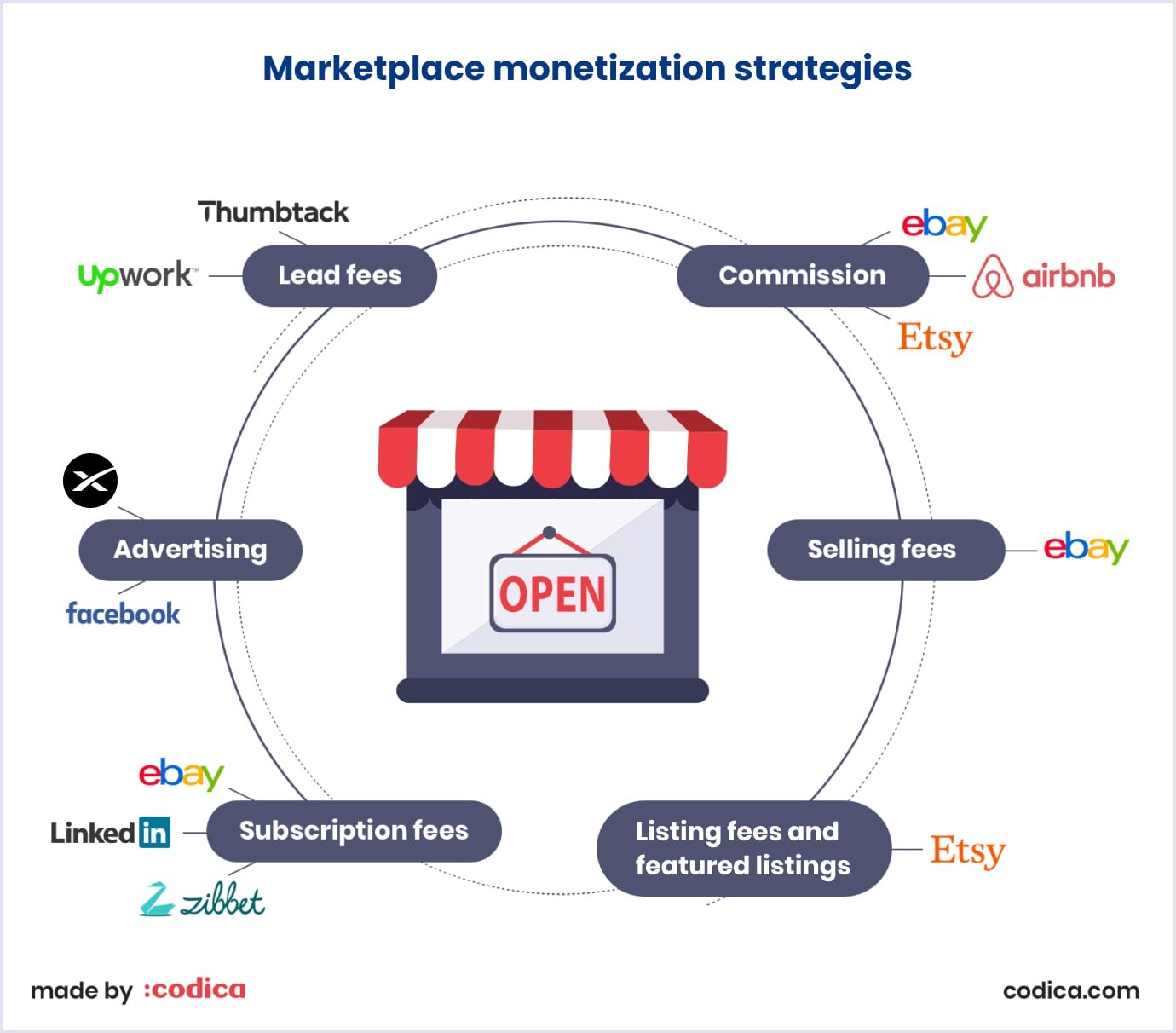
To wrap up the topic, choosing suitable revenue models is crucial for making a profit on your platform. Starting with one monetization strategy, you can progress to complex models. This way, you will help vendors make the most of your marketplace.
Write a business plan for the marketplace launch
Creating a business plan is crucial before starting online marketplace development. It outlines goals, tracks progress as the platform grows, and reduces risks by anticipating issues. Also, it serves as a must-have document when seeking third-party investors and demonstrating the viability of your marketplace idea for long-term success.
These are the main points your business plan should include:
- Review of your enterprise as a whole;
- Your marketplace description, including your goals and objectives;
- Description of products and services your vendors provide;
- Information about your target audience, the niche you chose, and competitors;
- The online marketplace strategy and ways of its implementation;
- Your team’s organizational structure;
- Financial plan with a revenue model and projections.
Here is a quick tip from our team. You can describe these general points as a business model canvas. This approach is helpful as you can involve your entire team in discussions and modify it whenever your business needs changes.
Search for compatible investors
Successful startuppers recommend looking for investors when you are ready to move your business to the next level. In this case, you have a strong base, and scaling your business is a real opportunity for you and investors. Thus, you can make it to the next investment round.
What is it that you can bring to the table and attract investors? These are problems that you solve, proven customer traction, an executable business plan, clarity about financial goals, and your marketplace’s trajectory compared to the competition. In return, you get investors’ networks, ideas, and advice.
Trusted platforms that offer investments for online marketplace startups include AngelList, Crunchbase, Kickstarter, and Y Combinator.
You may also like: Market Networks: The Future of Service Marketplaces
Define the required functionality
Your marketplace’s features are the core to ensure that buyers and sellers reach their goals and will return to your platform. Thus, defining functionality is a crucial step in planning your marketplace website.
Here is how you can select the features for your platform:
- Think of your marketplace’s goals and prioritize functionality accordingly;
- Add features based on your audience’s needs;
- Choose the primary features that would make your platform workable and marketable;
- Take into account costs and limitations when choosing third-party integrations and plug-ins.
Choose the best tech stack
The right technologies ensure your marketplace is robust, stable, and scalable. So, when choosing programming languages, frameworks, and integrations, remember the following crucial points. The technologies must ensure the following aspects:
- Compatibility with existing or future systems to ensure the proper work of your marketplace;
- Scalability to stand high traffic loads as your marketplace evolves;
- Performance for smooth user experiences;
- Affordability of licenses and paying for developers’ skills;
- Optimization of development processes;
- Security to protect your marketplace against vulnerabilities;
- Support with documentation and community;
- Flexibility with a view of improvements in your marketplace and emerging technologies;
- Long-term maintenance to keep your platform up-to-date over time.
Below is an overview of the technologies we use at Codica when building a marketplace. This tech stack ensures that the created platform meets the best development standards, aligns with the current trends in the market, and delights customers.
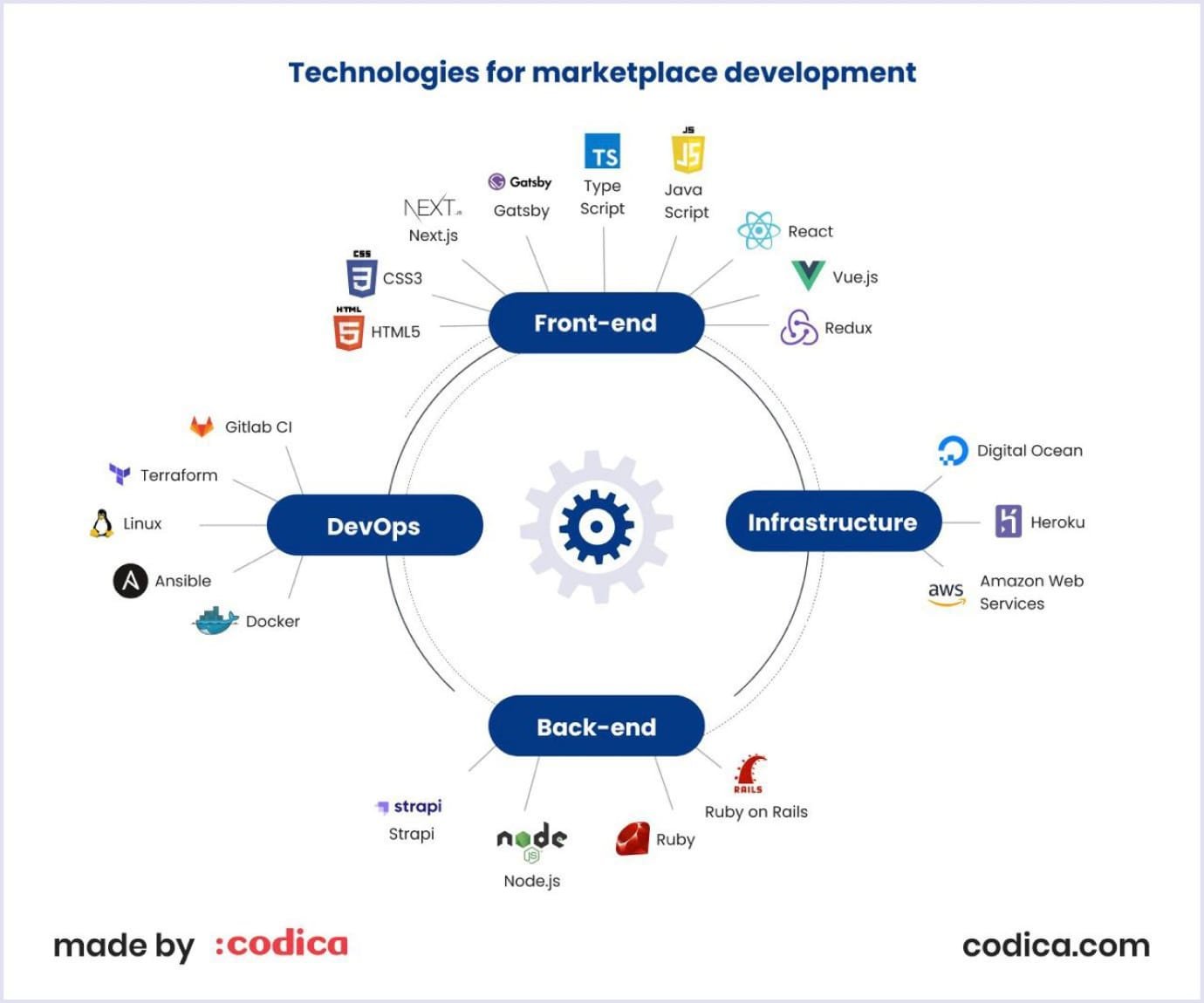
At Codica, we have selected a list of tools assisting us in developing scalable, secure, and high-quality online marketplaces. Now, we will share with you which tech stack we use. Also, you will learn what integrations we recommend for your future successful marketplace.
Frontend tech stack
The frontend is the visual part of your web platform. Visitors see and interact with this part of your solution. So, developing this part for an online marketplace website demands a deep understanding of users’ needs. For the frontend side, we use:
- JavaScript;
- TypeScript;
- React;
- Redux;
- Next.js;
- Vue.js;
- HTML5;
- CSS3.
Backend tech stack
The backend is the software part responsible for functioning as the internal part of a web solution. Of course, high-quality software should have a solid ‘backbone’ to perform smoothly. When creating a marketplace website, for the backend, our experts use:
- Ruby on Rails;
- Ruby;
- Node.js;
- Strapi.
DevOps tech stack components
Companies use the DevOps tech stack for continuous integration of operations. DevOps tools automate many recurring tasks. Thus, they improve overall performance. Also, these tools decrease the likelihood of manual faults during the development lifecycle. Our choice of DevOps tech stack when creating a marketplace includes the following tools:
- Linux;
- Ansible;
- Docker;
- GitLab CI;
- Terraform.
Databases tech stack
Databases are a significant part of the backend ecosystem. In brief, the database is accumulated data specially organized for fast search and removal from a computer. They deal with maintaining and processing a lot of data points. Here are the databases we use for building a marketplace:
- PostgreSQL;
- MySQL;
- MongoDB;
- Redis;
- Firebase;
- ElasticSearch.
Infrastructure software stack
At Codica, we prefer the following application deployment, provisioning, and configuration management tools:
- AWS;
- Digital Ocean;
- Heroku.
Integrations
In general, integrations enhance the functionality of the existing system. Thanks to their features, it becomes possible for the system to automate and complete a broad range of tasks. In brief, with the following integrations, we will help you create a marketplace website of high quality:
- Stripe;
- Google Analytics;
- Paypal;
- Mollie;
- Hotjar;
- Sentry;
- MailChimp;
- HubSpot;
- Uptime Robot;
- Skylight.
The process of picking a tech stack can be quite challenging. It requires careful discussion with stakeholders and thoughtful planning. Also, your development team should have vast practical experience.
Select the right development team
Your IT vendor ensures your platform is developed within the set timeframe, optimized, and secured. You can check reliable platforms for ratings and reviews to find such a team. Prominent portals are GoodFirms, Owler, and Clutch.
When you discover a company or team that seems reliable and experienced to you, review their portfolio. Their works should be relevant to your marketplace’s goals and show the needed expertise.
Another vital point when choosing a development team is how they communicate with you. If you can reach them out via different channels when needed, this is a sign of fruitful cooperation.
At Codica, we promote open communication and a collaborative approach to development. We are happy that our expertise, effort, and experience help companies connect with their customers. Our clients' success inspires us to refine our skills and innovate in further projects.
UI/UX design
Your marketplace website is a starting point where your customers discover your brand. Design is the first thing they see on your page. If the design elements and visuals help your customers buy and sell, you get more chances that they return to your platform.
Keep your marketplace design appealing, simple, recognizable, and accessible. Buyers and sellers with different preferences and capabilities should easily find their needs. Also, make your logo, colors, and fonts consistent on the website. This way, you will make interaction with your ecommerce website enjoyable.
When providing UI/UX design services, we follow the company’s brand guidelines and technical requirements. In addition, we review what would improve user experience with your marketplace and make relevant suggestions.
Further reading: The Ultimate Guide to Ecommerce Website Design
Develop an MVP first
Turning to minimum viable product development services helps you save resources and reach your goals faster. MVP is a version of your marketplace with the prioritized features. Thanks to the minimum of features, you develop and launch quickly. Also, as it is a marketable product, you can collect customer feedback and iterate as needed.
When startups turn to us with their marketplace projects, we recommend setting off with MVP development. The marketplace MVP development includes product discovery, UI/UX design, development, and quality assurance services.
This approach has helped our clients check their assumptions, reduce time to market, and see what must be improved. As a result, MVP projects brought positive business outcomes.
You may also like: How Automation Testing Increases Execution Speed, Test Coverage, and Effectiveness
Acquire users
So, you have built your MVP marketplace. How can you attract users to your platform? It relates to solving the chicken and egg challenge that we discussed above. The main point is to start from the side that is hard to gain and will bring value to your marketplace.
As Andrew Chen, a general partner at Andreessen Horowitz, puts it, the supply side is king. This opinion comes from his analysis of Uber for X potential and why it failed.
Your marketplace should start by acquiring the supply side and nurturing it. Then, the demand part of buyers will join the platform as the value will be obvious.
Build trust between sellers and buyers
Nurturing buyers and sellers is essential for your marketplace growth. Thus, applying particular strategies for building trust between buyers and sellers will strengthen your marketplace. They are as follows:
- Transparent policies. Be clear about return, refund, and dispute resolution policies. This approach instills confidence in buyers and sellers about the platform’s fairness;
- Verified profiles. Add a verification system for sellers and buyers. It will reduce the risk of fraud;
- Ratings and reviews. Enable buyers to leave feedback for sellers, and vice versa, so vendors could respond to negative reviews. This communication will be a valuable source for other platform users;
- Secure payments. Ensure that payments are safe on your platform with due encryption;
- Prompt customer support. Provide efficient customer support to resolve issues between sellers and buyers. Such commitment to customer satisfaction builds trust in your platform;
- Quality assurance. Include measures that ensure quality checks. Enforcing high-quality standards maintains trust;
- Reference materials. Provide guides for sellers and buyers. Thus, they will be able to resolve common issues themselves. Also, such materials will help sellers and buyers navigate the platform and use it in their best interests;
- Regulatory compliance. Highlight that your platform follows the latest quality and security standards and complies with regulations.
For example, Amazon provides several common categories that people often search for. Customers can contact the support service if they need specific help with other issues.
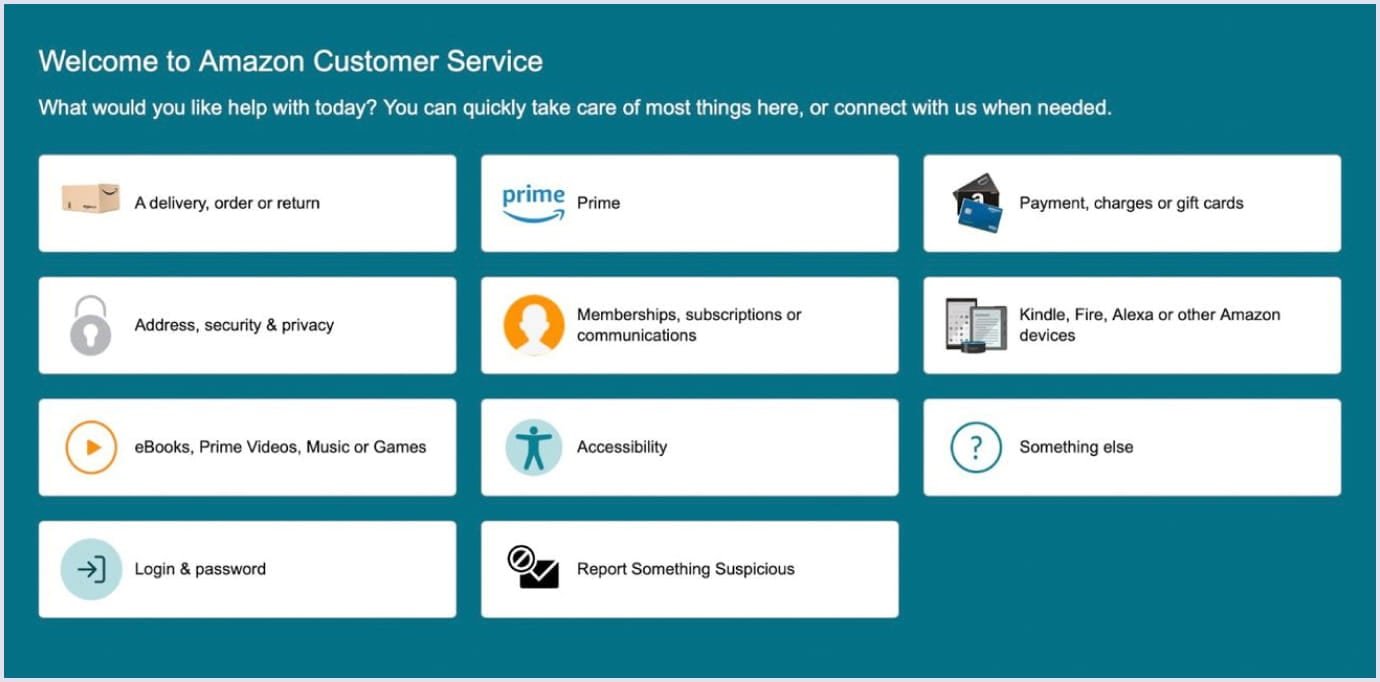
Source: Amazon.com
Platform promotion
We have discussed a strategy to build an online marketplace. The next question is how you can promote your brand-new ecommerce platform.
An efficient marketplace marketing strategy helps attract vendors and buyers to your online marketplace and makes it more visible on the web. Use the following tips to gain sellers' and buyers' attention:
- Promote your platform via ads on social media, including Instagram, Facebook, and LinkedIn;
- Become a part of workshops or educational meetups. Attend these events to connect with your potential vendors and buyers;
- Visit trade fairs to search for sellers. Find a subtle way to get their contact information. Thus, you will be able to reach them afterward;
- Organize live events and collaborate with celebrities;
- Create joint promotions with complementary brands and influencers;
- Offer discounts;
- Provide affiliate and referral programs.
For example, Shopify offers affiliate opportunities for content creators, influencers, course educators, and review sites. To be eligible for an affiliate program, you should have an established audience and experience with Shopify.
Read also: How to Build Online Marketplace and Not Fail
Find tools to monitor different aspects of your marketplace
Starting a new business is always tricky. However, the working process will be well-organized with the right tools, and your enterprise will run smoothly.
So, below are examples of such applications and tools:
- Google Analytics is used to analyze your marketplace traffic. This tool helps you better understand your audience, perform search engine optimization (SEO), and monitor marketing parameters;
- Salesforce is a powerful CRM (customer relationship management) tool. It allows you to connect to your users and organizes your clients' pipeline from the first contact to making a deal;
- Mention is a great social media management tool for showing mentions of your project on different resources;
- Buffer is an excellent assistant for scheduling posts on social media. This marketplace app development solution makes your promotion campaign as smooth as possible. You only need to buffer a blog post, and the service will publish it automatically.
Protect your intellectual property
Now, it’s time to protect your business legally. Define if you need to set copyrights, patents, trademarks, or special licenses. Why is it important?
Other people can make a profit from your idea if you do not protect your concept. So, you should have the documentation that proves you own the assets mentioned.
Here are the ways that will help you make your product idea safe and sound:
- A patent is a set of exclusive rights. It is granted to an inventor for a restricted period in exchange for detailed public disclosure of an invention;
- A trademark is used to represent a company or product. It can be a symbol, word, or several legally registered words. For instance, you need it to protect your project name;
- A copyright is a collection of exclusive rights granted to an inventor and spread over a literary work, song, movie, or software. For example, you can protect your website content, including articles, descriptions, etc.;
- A domain name is the part of a network address that identifies it as belonging to a particular domain.
Applying these methods, you can ensure that your marketplace is highly protected. Additionally, your web project will be recognized by the courts and competitors.

Costs to build a marketplace website
You know the technical side of building an online marketplace. Now, let’s talk about money. Below, we give you an overview of possible development spending and tips to keep your costs modest.
Ready-made vs. custom development
Simply put, a ready-made website is fast to develop. Meanwhile, custom development requires effort, time, and, thus, higher costs. At the same time, the template-based website is tricky to adapt to specific business needs, and custom software development services help you get tailored features that you need for growing your business.
The table below is a more detailed overview of the strengths and weaknesses of both approaches. You can consider the costs of building a marketplace website and choose a method that suits best your current business needs.
| Criteria | Ready-made template | Custom solution |
|---|---|---|
| Upfront costs | $0 - $3500 per month | $68,400 for an MVP marketplace, with a possible range of $10,000 - $150,000 |
| Time to launch | 1 - 3 months | 2 - 6 months |
| Maintenance and support | $500 - $3,500 per year | $1000 - $5,000 per year |
| Scalability | Scalability limits are likely | Scalable per any business needs |
| Custom functionality | The feature set is distinguished by the website builder | Features are customizable per your business needs |
| Integration | May require additional resources for integration with existing systems | Smoothly integrates with existing systems and technologies |
| Vendor reliance | Depending on the builder provider’s policies and tech set | Autonomy in choosing technologies and development approaches |
| Long-term spending | Subscription costs that accrue over time | Costs depend on the marketplace’s scale |
| Suits best if | You have simple requirements, a tight budget, and standard features | You have a business with a foreseen growth, custom feature set, and significant market goals |
Feature set
When you create a marketplace website from scratch, your chosen features will define the development cost. The more features you get, the higher the cost. On average, marketplace price ranges between $40,000 and $80,000, reaching $100,000 - $150,000 for websites with complex architecture.
When you partner with an IT agency, they will calculate prices based on the feature-by-feature estimates. For example, an Eastern European developers’ rate of $50 per hour means that developing a feature will cost between $3,000 and $8,000.
You may also like: Building a Future-Ready Marketplace with MACH Architecture
Developers’ hourly rate
Today, you can hire a specialist from around the globe via different platforms and communication technologies. It makes professional help accessible. Nevertheless, it is necessary to consider that geographical location influences time zone differences and, more importantly, defines developers’ hourly rates.
Another crucial factor is developers' expertise and experience level. While simple marketplace websites can be done at the middle level, development is more costly when it involves senior specialists for sophisticated solutions.
According to Arc, senior professionals charge $81 - $160 per hour in North America, $41 - 160 hourly in Western Europe, and $41 - 120 hourly in Eastern Europe. The rates of middle specialists in the same regions range between $41 - $120 per hour.
Examples and costs of building a marketplace
For your convenience, we have prepared a collection of prominent marketplaces to give you a quick peek at possible expenses for crafting a similar website. Check them out below.
Amazon
As Jeff Bezos, Amazon’s founder, states, the marketplace’s success stems from a sharp focus on customer experience. That is what keeps Amazon among the prominent marketplaces.
Key features that make the marketplace stand out include the following:
- Order management;
- Returns and refund;
- Payment management;
- Checking carrier info;
- Accessibility features.
The table below shows the cost of features for an Amazon-like MVP.
| How much does it cost to build a multi-vendor marketplace like Amazon? | ||
|---|---|---|
| Features | Time, hours | Cost ($50/h) |
| Design | ||
| UX development | 64 | $3,200 |
| UI development | 96 | $4,800 |
| Architecture | ||
| Project setup | 16 | $800 |
| DB structure | 32 | $1,600 |
| Integrations | ||
| Payment (Stripe or PayPal) | 64 | $3,200 |
| Shipment (Shippo) | 32 | $1,600 |
| Main functionality | ||
| Authorization and security | 72 | $3,600 |
| User profiles | 42 | $2,100 |
| Home page | 64 | $3,200 |
| Search and filters | 72 | $3,600 |
| Product page | 42 | $2,100 |
| Reviews & ratings | 48 | $2,400 |
| Shopping cart | 64 | $3,200 |
| Notifications | 32 | $1,600 |
| Buyer panel | 120 | $6,000 |
| Vendor panel | 156 | $7,800 |
| Admin panel | 120 | $6,000 |
| Wishlist | 32 | $1,600 |
| Non-development activity | ||
| Project management | 64 | $3,200 |
| Quality assurance | 96 | $4,800 |
| Code review | 48 | $2,400 |
| Total | 1376 | $68,800 |
Airbnb
Joe Gebbia and Brian Chesky started their marketplace with three core parameters:
Signup/login process; An option to be a traveler or host; An option to monitor new listings.
More features were added to this base to improve and expand the platform. They help connect guests and hosts, choose flexible dates, and manage the hosting process.
Check out the table below with an estimated cost of building a marketplace website like Airbnb.
| How much does it cost to build a marketplace like Airbnb? | ||
|---|---|---|
| Features | Time, hours | Cost ($50/h) |
| Design | ||
| UX development | 64 | $3,200 |
| UI development | 96 | $4,800 |
| Architecture | ||
| Project setup | 16 | $800 |
| DB structure | 32 | $1,600 |
| Integrations | ||
| Payment (Stripe or PayPal) | 64 | $3,200 |
| Main functionality | ||
| Authorization and security | 48 | $2,400 |
| User profiles | 64 | $3,200 |
| Home page | 64 | $3,200 |
| Search and filters | 96 | $4,800 |
| Reviews & ratings | 32 | $1,600 |
| Payout | 32 | $1,600 |
| Notifications | 64 | $3,200 |
| Messenger | 32 | $1,600 |
| Geolocation feature | 32 | $1,600 |
| Managing listings | 64 | $3,200 |
| Booking system | 64 | $3,200 |
| Property page | 72 | $3,600 |
| Guests panel | 48 | $2,400 |
| Hosts panel | 72 | $3,600 |
| Admin panel | 80 | $4,000 |
| Non-development activity | ||
| Project management | 64 | $3,200 |
| Quality assurance | 80 | $4,000 |
| Code review | 32 | $1,600 |
| Total | 1312 | $65,600 |
Etsy
Rob Kalin, Chris Maguire, and Haim Schoppik started this marketplace to connect people selling handmade items with buyers online. In the first year of their website, the traffic boomed as they added new features to improve sellers’ exposure.
Today, Etsy has a $6.9 billion valuation. Thanks to its versatile functionality and care for product diversity and quality, Etsy stays among the major players in the ecommerce world.
Check the table below for a rough estimate of building an Etsy-like platform.
| Costs of creating a website similar to Etsy | ||
|---|---|---|
| Features | Time, hours | Cost ($50/h) |
| Design | ||
| UX development | 64 | $3,200 |
| UI development | 96 | $4,800 |
| Architecture | ||
| Project setup | 24 | $1,200 |
| DB structure | 32 | $1,600 |
| Integrations | ||
| Payment (Stripe or PayPal) | 64 | $3,200 |
| Shipment (Shippo) | 32 | $1,600 |
| Main functionality | ||
| Authorization and security | 72 | $3,600 |
| User profiles | 42 | $2,100 |
| Home page | 64 | $3,200 |
| Search and filters | 72 | $3,600 |
| Product page | 32 | $1,600 |
| Reviews & ratings | 48 | $2,400 |
| Shopping cart | 84 | $4,200 |
| Notifications | 32 | $1,600 |
| Buyer panel | 96 | $4,800 |
| Vendor panel | 120 | $6,000 |
| Admin panel | 72 | $3,600 |
| Wishlist | 32 | $1,600 |
| Non-development activity | ||
| Project management | 72 | $3,600 |
| Quality assurance | 92 | $4,600 |
| Code review | 36 | $1,800 |
| Total | 1278 | $63,900 |
Alibaba
The Alibaba.com project started in 1999 to serve wholesale traders. Along with essential features for buyers and sellers, this wholesale platform adds more services for a better user experience. For example, Alibaba.com supports safe operations with suppliers. Also, it provides secure payment options with ongoing support and protection against product and shipping issues.
The table below gives rough numbers for building a website like Alibaba.com.
| How much does it cost to build a website like Alibaba? | ||
|---|---|---|
| Features | Time, hours | Cost ($50/h) |
| Design | ||
| UX development | 64 | $3,200 |
| UI development | 96 | $4,800 |
| Architecture | ||
| Project setup | 16 | $800 |
| DB structure | 32 | $1,600 |
| Integrations | ||
| Payment (Stripe or PayPal) | 64 | $3,200 |
| Shipment (Shippo) | 32 | $1,600 |
| Main functionality | ||
| Authorization and security | 72 | $3,600 |
| User profiles | 42 | $2,100 |
| Home page | 64 | $3,200 |
| Search and filters | 72 | $3,600 |
| Product page | 42 | $2,100 |
| Reviews & ratings | 48 | $2,400 |
| Shopping cart | 64 | $3,200 |
| Notifications | 32 | $1,600 |
| Buyer panel | 120 | $6,000 |
| Vendor panel | 156 | $7,800 |
| Admin panel | 120 | $6,000 |
| Wishlist | 32 | $1,600 |
| Live chat response | 16 | $800 |
| Non-development activity | ||
| Project management | 64 | $3,200 |
| Quality assurance | 96 | $4,800 |
| Code review | 48 | $2,400 |
| Total | 1392 | $69,600 |
AliExpress
It was started to support small Chinese businesses. Today, this marketplace boasts over 150 million customers. The platform provides quick and secure payments, convenient order management, and prompt customer support. Its distinguished feature is that it supports many languages and local payment channels.
To build a website like AliExpress, check the table below for an estimate.
| How much does it cost to build a marketplace like AliExpress? | ||
|---|---|---|
| Features | Time, hours | Cost ($50/h) |
| Design | ||
| UX development | 64 | $3,200 |
| UI development | 96 | $4,800 |
| Architecture | ||
| Project setup | 16 | $800 |
| DB structure | 32 | $1,600 |
| Integrations | ||
| Payment (Stripe or PayPal) | 64 | $3,200 |
| Shipment (Shippo) | 32 | $1,600 |
| Main functionality | ||
| Authorization and security | 72 | $3,600 |
| User profiles | 42 | $2,100 |
| Home page | 64 | $3,200 |
| Search and filters | 72 | $3,600 |
| Product page | 42 | $2,100 |
| Reviews & ratings | 48 | $2,400 |
| Shopping cart | 64 | $3,200 |
| Notifications | 32 | $1,600 |
| Buyer panel | 120 | $6,000 |
| Vendor panel | 156 | $7,800 |
| Admin panel | 120 | $6,000 |
| Wishlist | 32 | $1,600 |
| Non-development activity | ||
| Project management | 64 | $3,200 |
| Quality assurance | 96 | $4,800 |
| Code review | 48 | $2,400 |
| Total | 1376 | $68,800 |
eBay
Pierre Omidyar started this online auction website as a hobby in 1995. As of Q3 2024, eBay generated around $2.6 billion in revenue.
The marketplace’s functionality serves buyers and sellers with relevant support, provides returns, and encourages users to build affiliate partnerships. The platform includes listing management, shows item conditions, offers convenient payment systems, and allows for tracking the shipment.
The table below presents the cost of creating an online marketplace like eBay.
| The cost of building an auction website like eBay | ||
|---|---|---|
| Features | Time, hours | Cost ($50/h) |
| Design | ||
| UX development | 56 | $2,800 |
| UI development | 80 | $4,000 |
| Architecture | ||
| Project setup | 16 | $800 |
| DB structure | 32 | $1,600 |
| Integrations | ||
| Payment (Stripe or PayPal) | 64 | $3,200 |
| Shipment (Shippo) | 32 | $1,600 |
| Main functionality | ||
| Authorization and security | 64 | $3,200 |
| User profiles | 42 | $2,100 |
| Home page | 64 | $3,200 |
| Search and filters | 72 | $3,600 |
| Product page | 42 | $2,100 |
| Auction functionality | 104 | $5,200 |
| Reviews & ratings | 48 | $2,400 |
| Shopping cart | 64 | $3,200 |
| Notifications | 32 | $1,600 |
| Buyer panel | 96 | $4,800 |
| Vendor panel | 120 | $6,000 |
| Admin panel | 104 | $5,200 |
| Non-development activity | ||
| Project management | 48 | $2,400 |
| Quality assurance | 64 | $3,200 |
| Code review | 48 | $2,400 |
| Total | 1292 | $64,600 |
Indeed
This marketplace helps employers and job seekers find each other based on specific criteria. Indeed provides employers and job seekers with advanced search thanks to integration with 300+ applicant tracking systems with free synchronization.
Indeed’s rich functionality helps recruiters and companies streamline the hiring process. At the same time, the platform benefits job seekers who can showcase their skills to a vast pool of companies.
If you plan to build a website like Indeed or Glassdoor, view the table below to learn the preliminary cost.
| How much does it cost to start your own job search website like Indeed? | ||
|---|---|---|
| Features | Time, hours | Cost ($50/h) |
| Design | ||
| UX development | 64 | $3,200 |
| UI development | 96 | $4,800 |
| Architecture | ||
| Project setup | 16 | $800 |
| DB structure | 32 | $1,600 |
| Integrations | ||
| Payment (Stripe or PayPal) | 64 | $3,200 |
| Main functionality | ||
| Authorization and security | 72 | $3,600 |
| User profiles | 40 | $2,000 |
| Home page | 48 | $2,400 |
| Notifications | 32 | $1,600 |
| Search & filters | 64 | $3,200 |
| Company reviews | 32 | $1,600 |
| Messenger | 32 | $1,600 |
| Company page | 80 | $4,000 |
| Job listings | 48 | $2,400 |
| Wishlist | 32 | $1,600 |
| Job posting | 48 | $2,400 |
| CV builder | 96 | $4,800 |
| Salary calculator | 48 | $2,400 |
| Employers panel | 72 | $3,600 |
| Applicants panel | 72 | $3,600 |
| Admin panel | 96 | $4,800 |
| Non-development activity | ||
| Project management | 64 | $3,200 |
| Quality assurance | 80 | $4,000 |
| Code review | 32 | $1,600 |
| Total | 1360 | $68,000 |
Fiverr
Micha Kaufman and Shai Wininger founded the company in 2010. They created a micro-job website using marketplace techniques. Thus, they resolved challenges when freelancers and businesses try to connect. The features, like project dashboards, advertised gigs, gig packages, gamification, and clear communication, serve this purpose best.
Below, we prepared a table with the cost overview for a micro-job website.
| The expected cost to make an online freelance marketplace like Fiverr | ||
|---|---|---|
| Features | Time, hours | Cost ($50/h) |
| Design | ||
| UX development | 64 | $3,200 |
| UI development | 96 | $4,800 |
| Architecture | ||
| Project setup | 16 | $800 |
| DB structure | 32 | $1,600 |
| Integrations | ||
| Payment (Stripe or PayPal) | 64 | $3,200 |
| Main functionality | ||
| Authorization and security | 72 | $3,600 |
| Account settings | 40 | $2,000 |
| Home page | 56 | $2,800 |
| Search & filters | 96 | $4,800 |
| Contractor page | 80 | $4,000 |
| Reviews & ratings | 54 | $2,700 |
| Chat | 48 | $2,400 |
| Gig package form | 32 | $1,600 |
| Project dashboard | 48 | $2,400 |
| Ad posting form | 54 | $2,700 |
| Notifications | 32 | $1,600 |
| Business panel | 96 | $4,800 |
| Contractors panel | 104 | $5,200 |
| Admin panel | 120 | $6,000 |
| Non-development activity | ||
| Project management | 64 | $3,200 |
| Quality assurance | 80 | $4,000 |
| Code review | 32 | $1,600 |
| Total | 1380 | $69,000 |
Udemy or Coursera
These websites make education accessible to millions of people. Their approaches are different, yet they serve the same purpose. Thus, Udemy and Coursera help people get an education and grow professionally.
The platforms’ distinguished features include the following:
Personalized recommendations; Specific categories covering various disciplines; Resources for course creation; Certificate programs; Refunds; Feedback and rating systems.
We give a table below with the cost of building an e-learning platform for a convenient review.
| HThe cost of creating an e-learning website like Udemy or Coursera | ||
|---|---|---|
| Features | Time, hours | Cost ($50/h) |
| Design | ||
| UX development | 64 | $3,200 |
| UI development | 96 | $4,800 |
| Architecture | ||
| Project setup | 16 | $800 |
| DB structure | 32 | $1,600 |
| Integrations | ||
| Payment (Stripe or PayPal) | 64 | $3,200 |
| Main functionality | ||
| Authorization and security | 72 | $3,600 |
| User profiles | 42 | $2,100 |
| Home page | 48 | $2,400 |
| Search & filters | 64 | $3,200 |
| Product page | 80 | $4,000 |
| Reviews & ratings | 32 | $1,600 |
| Shopping cart | 64 | $3,200 |
| Notifications | 32 | $1,600 |
| Course page (Course overview, course content, Q&A, Announcements, Bookmarks) | 80 | $4,000 |
| Course creation (the ability to upload content in different formats, create quizzes and tests) | 96 | $4,800 |
| Dashboard for teachers (analytical information about students) | 96 | $4,800 |
| Course management | 54 | $2,700 |
| Admin panel | 96 | $4,800 |
| Non-development activity | ||
| Project management | 64 | $3,200 |
| Quality assurance | 80 | $4,000 |
| Code review | 32 | $1,600 |
| Total | 1304 | $65,200 |
The cost of building a mobile marketplace app
Along with a website visible for desktops, consider building a mobile marketplace app. It is a version of your marketplace that provides your buyers and sellers with all the features on mobile devices. Regarding how widespread mobile devices are, you gain an increase in audience engagement with an app.
The features you include define how much it costs to build a marketplace app. The cost of marketplace app development ranges between $50,000 and $80,000, making $65,000 the rough average.
Our proven expertise in building a marketplace
When you turn to us to build a marketplace, be sure our hands-on experience will benefit your business. With our qualifications and knowledge of different industries, you get cost-effective development of a technically optimized platform. Our approach ensures the marketplace’s smooth operation and a delightful customer experience.
Be it an MVP or an expanded website, we use the best practices to make your online marketplace accurate, robust, and scalable. Our tech stack ensures your platform will evolve with changing customer feedback, technologies, and industry trends.
So far, we have helped our clients build a marketplace from scratch, redesign a platform, optimize SEO, choose the right integrations, and more. Our enhancements bring tangible results in improved marketplace performance and help businesses thrive.
Let examples of successful online marketplaces from our portfolio speak for us and inspire you to build one.
Domains marketplace Dan.com
As a platform with 17 million domains listed, Dan.com turned to us with the need to revamp its Portfolio core section. Our task was to build the new Portfolio from scratch, redesign the user interface part, and make the user experience on this domain sale website more delightful.
As a result, we made foundational changes to make the customer experience with the platform enjoyable and convenient. The following are the improvements we have made to the marketplace Portfolio:
- Enabled bulk changes to help sellers renew thousands of domain names with just one click;
- Improved speed so a page with 1000 domains loads in less than 2 seconds;
- Optimized search by adding filters and sorting options, as well as an infinite scroll feature;
- Improved import and export of domains;
- Redesigned the navigation bar and made it take up less space in the marketplace;
- Enabled creating domain categories on buyers’ public page so sellers can filter domains by such categories;
- Revamped mobile design so you can manage domains on the go.
The video below explains how the platform works after our enhancements.
Boat selling website Trade A Boat
This marketplace for boats is Australia’s favorite place to sell and buy boats and marine equipment. This platform has also been a place for publishing news, reviews, and ads for 40 years.
The platform needed more sophistication as its MVP stage was already in the past. Our challenge was redesigning the platform and making it more appealing and accessible for users. Also, the task was to improve lead generation and select integrations that matched current inventory management systems of the Australian marketplace.
The outcomes are brilliant:
- The platform received better rankings and, consequently, more visits;
- Lead generation performance grew 480% compared to the previous platform;
- The mobile version that we built as a progressive web application brought an increase in conversions;
- New integrations help with inventory management across Australia;
- UI/UX redesign brought user delight and engagement with the marketplace.
The video below is valuable feedback from our client that we are happy to share.
Online service marketplace for PlanMyKids
This online service marketplace helps parents find and plan after-school activities for their kids. David Watkins, founder of PlanMyKids, is a parent himself. Having struggled with planning their kids’ leisure, he soon discovered many parents were in the same situation. This is how the marketplace idea appeared.
The task was to create a minimum viable product to help David test the idea with the least effort. The platform should work perfectly on desktop and mobile devices. Also, it should provide personalized suggestions based on user criteria.
Our cooperation with David led to a beautiful platform that helps parents and their kids find activities based on interests, age, location, and time. We have provided progressive web application services to make the user experience native-like on any device.
The children’s leisure online planner includes kids’ interests, family preferences, and budget. Parents get an itinerary with suggested leisure opportunities by filling out a simple questionnaire. Thus, the itinerary highlights location, price, age, camp type, and a brief description of activities.
We helped David remove fancy features and include those that serve customers best. Based on the focus groups’ feedback, we narrowed down the functionality and ensured that development would be within a planned budget. This was important for David’s bootstrapped company.
Check out the video below to see how the marketplace works on mobile devices.
Back to you
Building a marketplace is a comprehensive task. It involves product discovery, UI/UX design, development, testing, and maintenance. UI/UX design, features, technologies, and third-party integrations define the technical side of your marketplace. They help you make your marketplace a convenient and enjoyable place for your customers.
It is vital that your platform runs continuously and is protected against security risks. Thus, it would be best to have a reliable team of qualified professionals to help you build a marketplace within a set timeframe and budget.
As an experienced online marketplace development company, we will use our expertise to ensure the robust and smooth operation of your selling platform. Feel free to contact us. We will discuss your project and give you a free quote.


